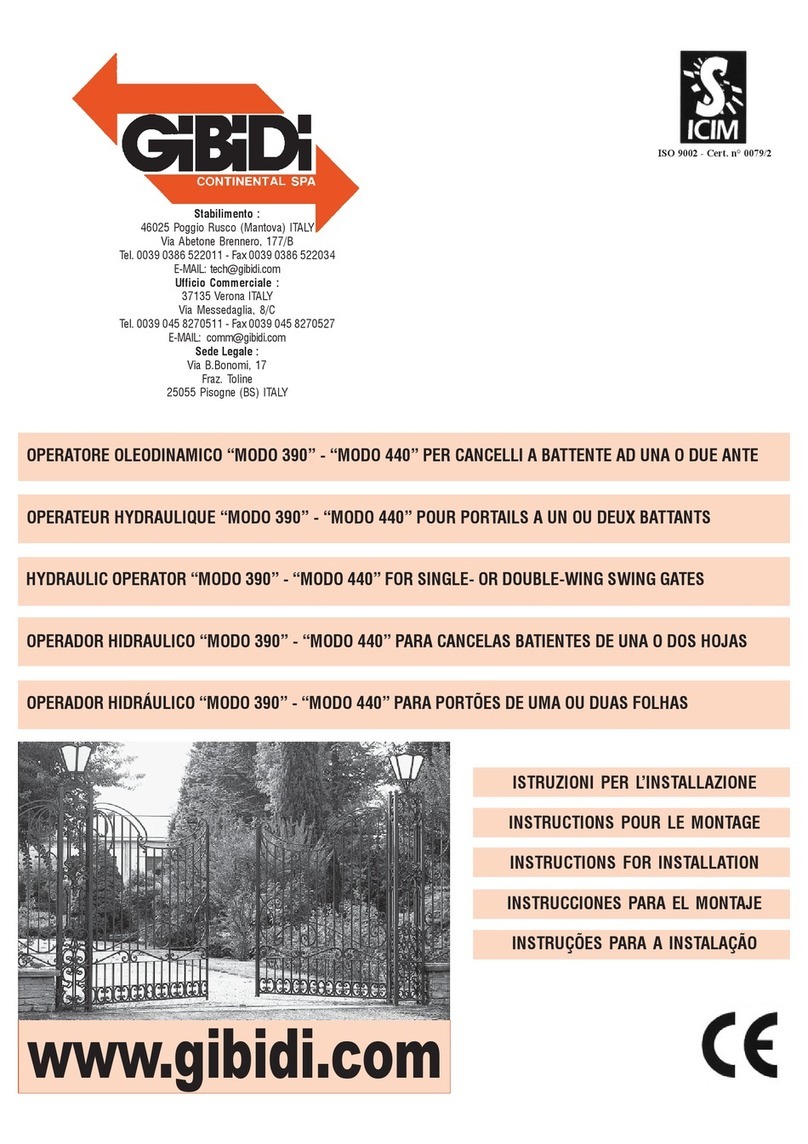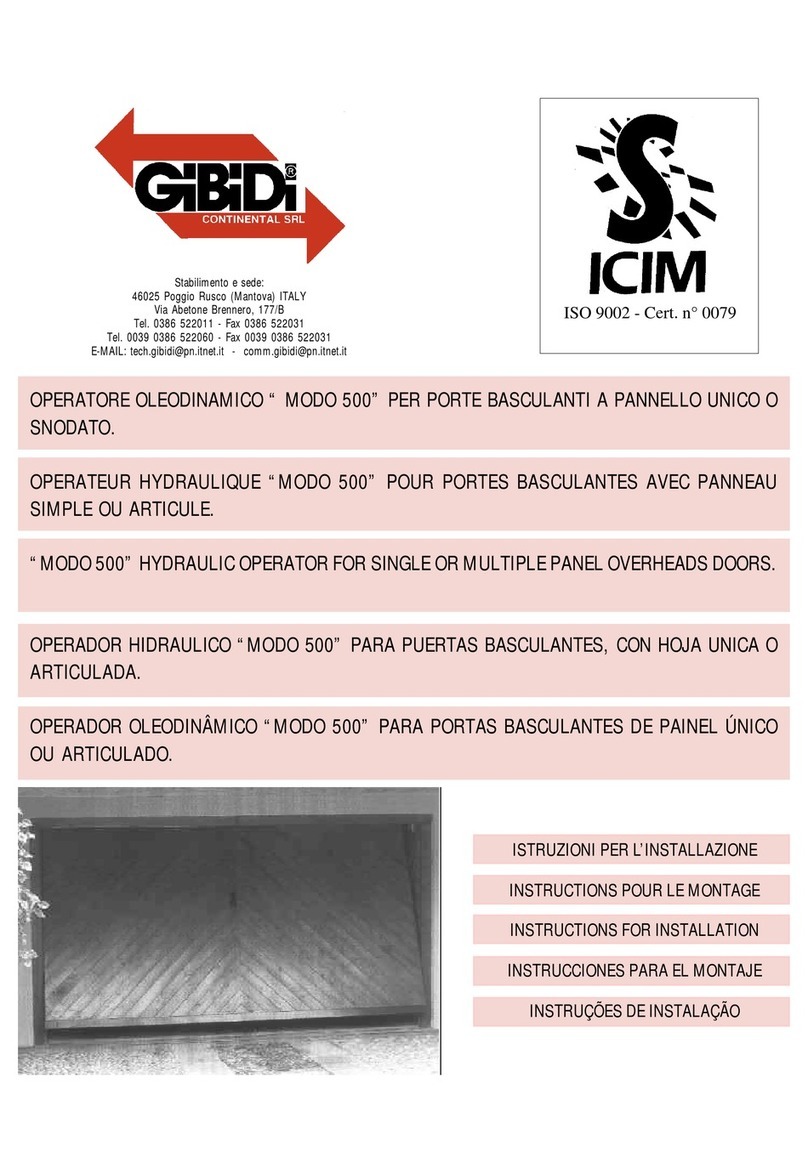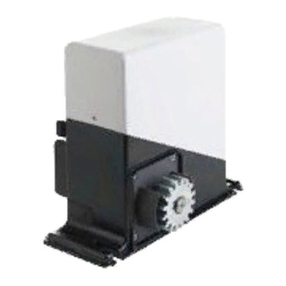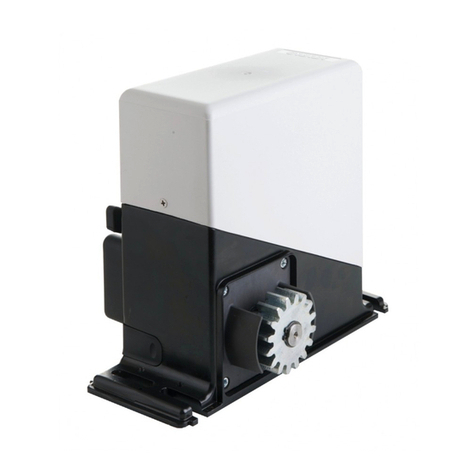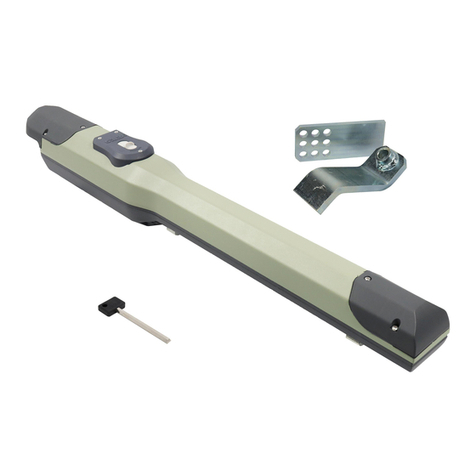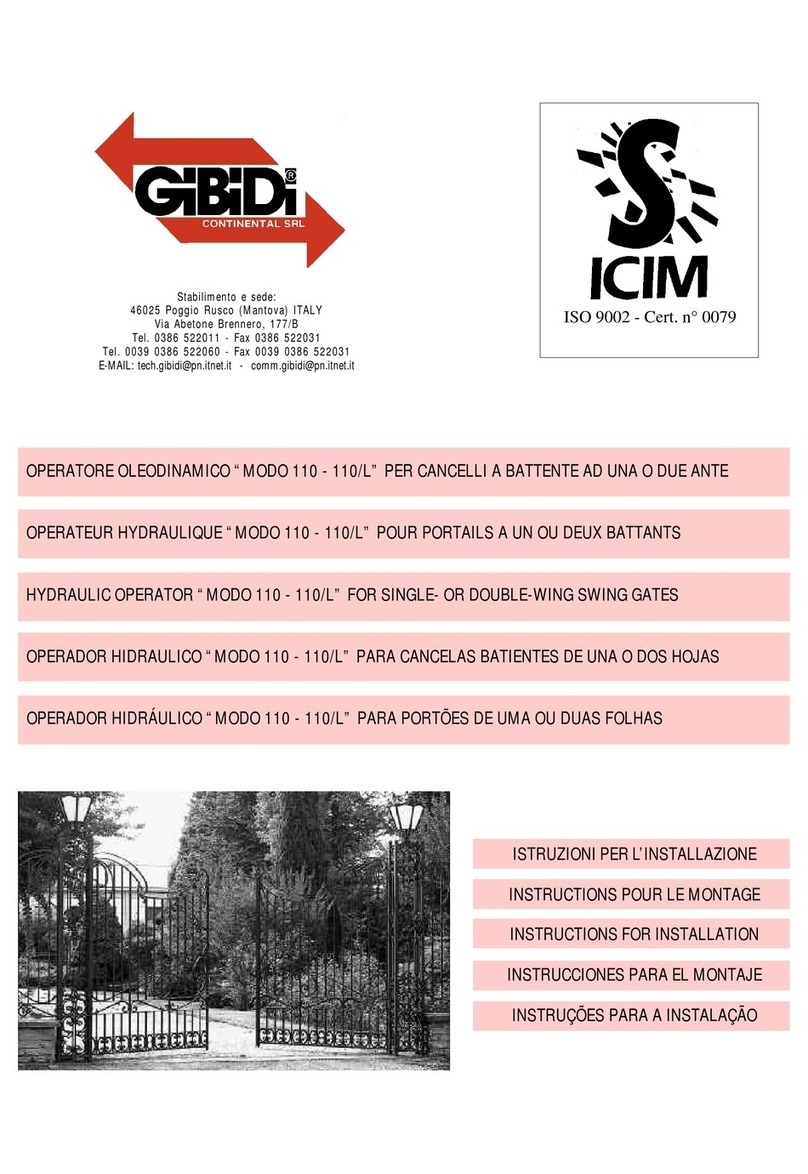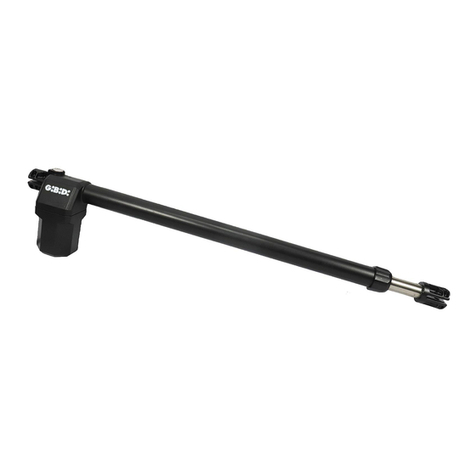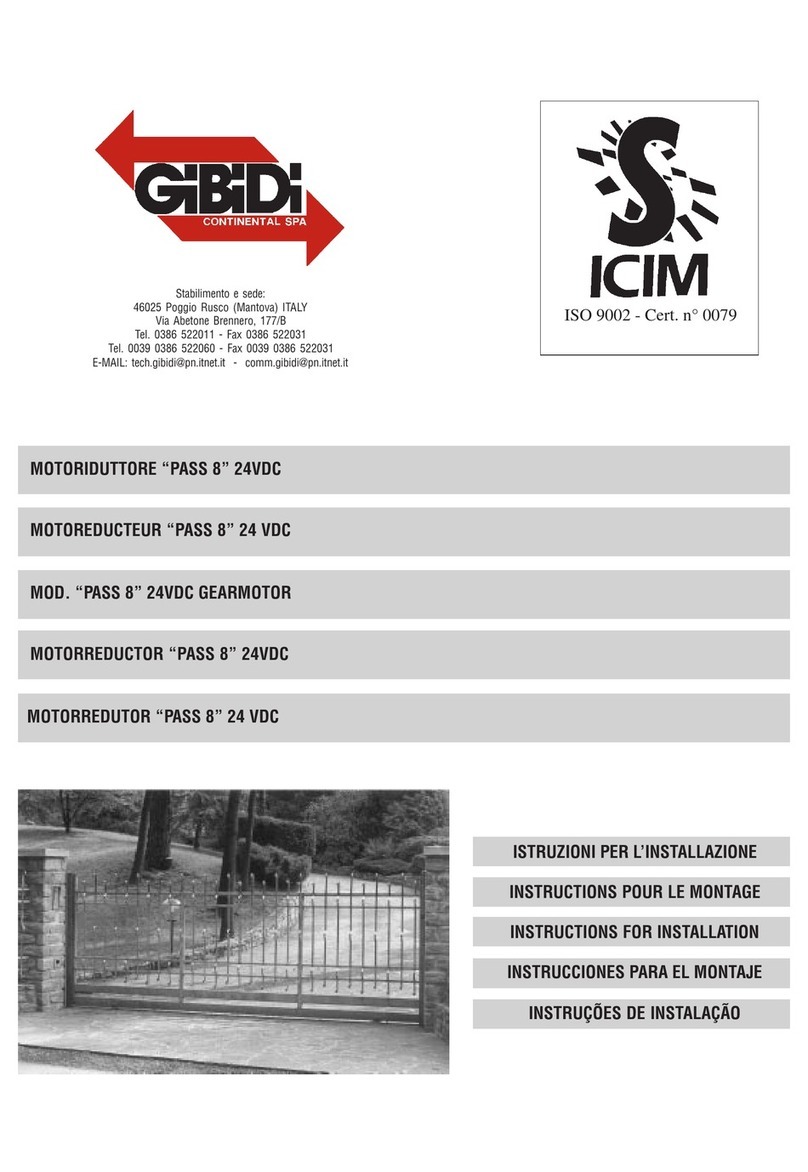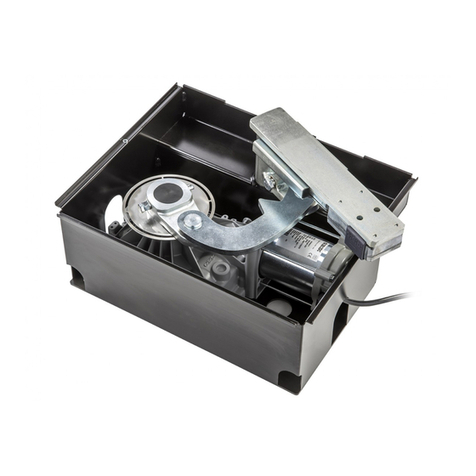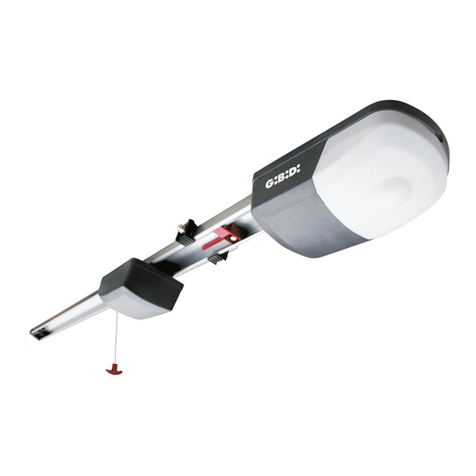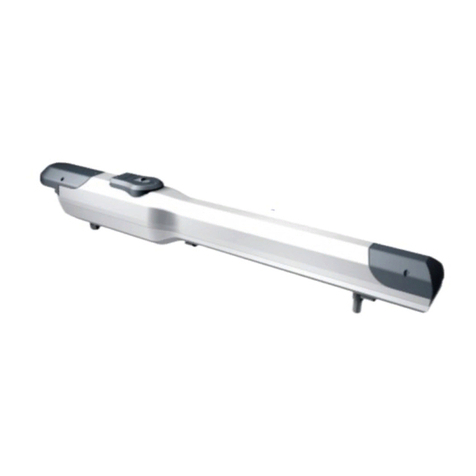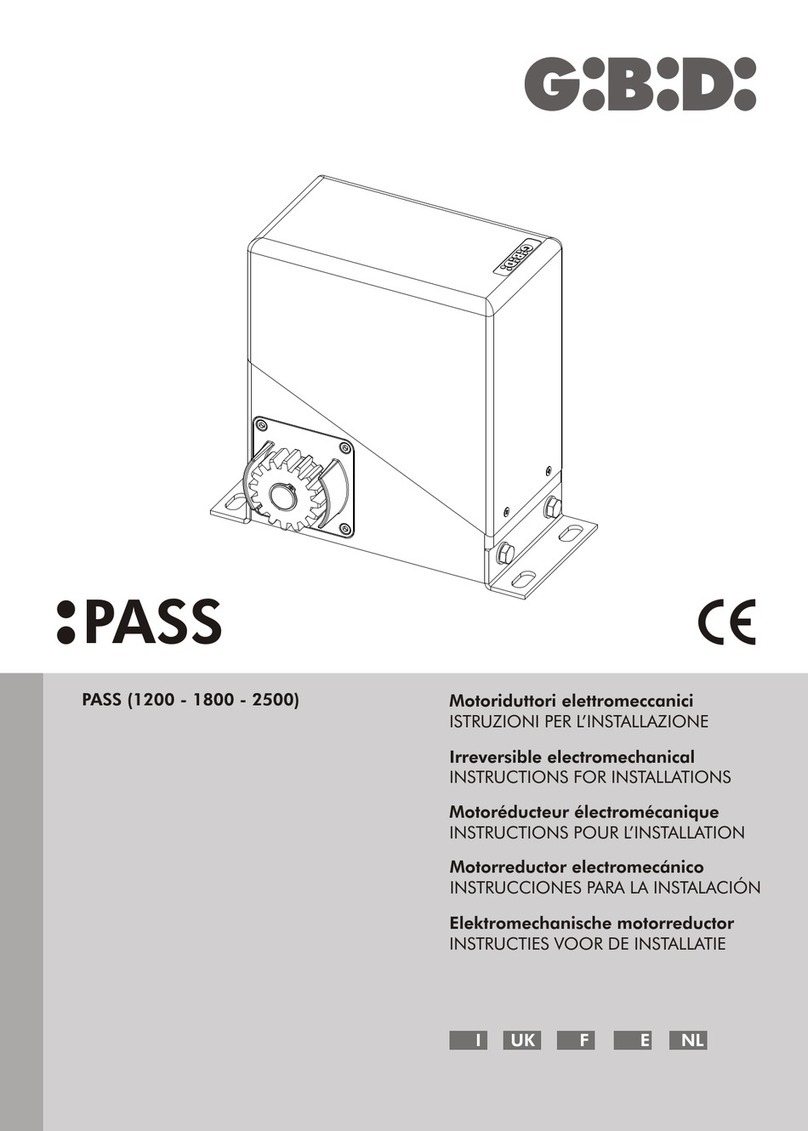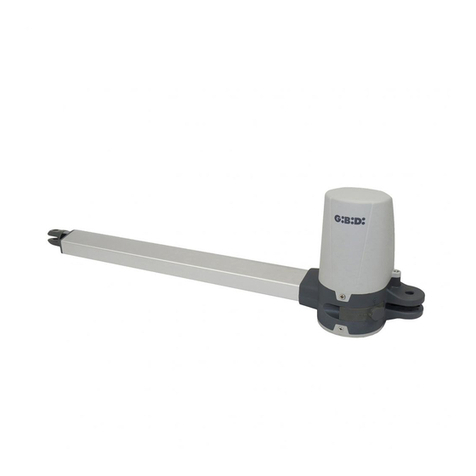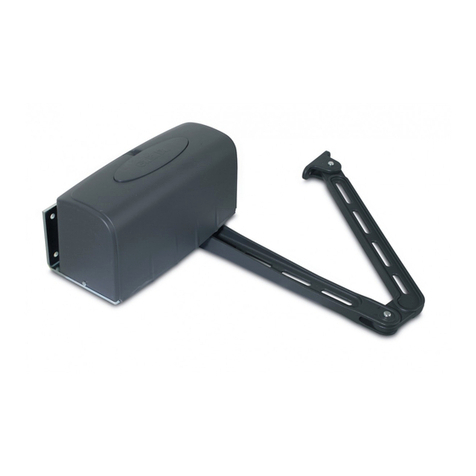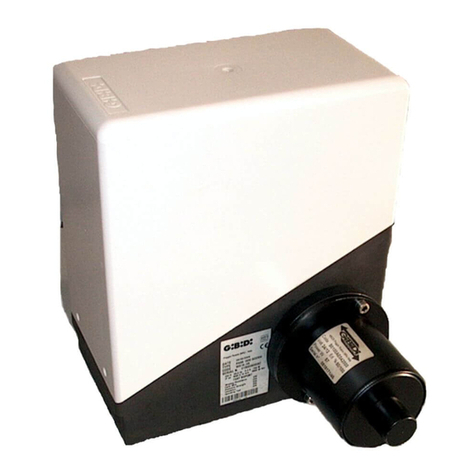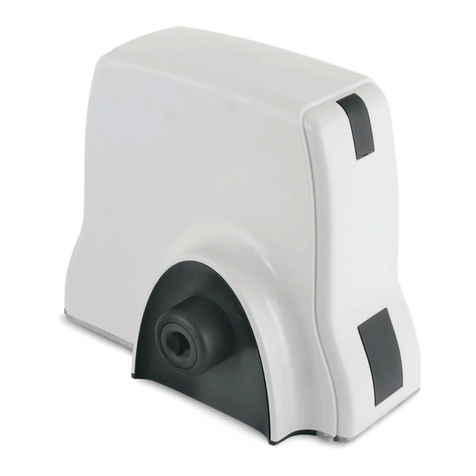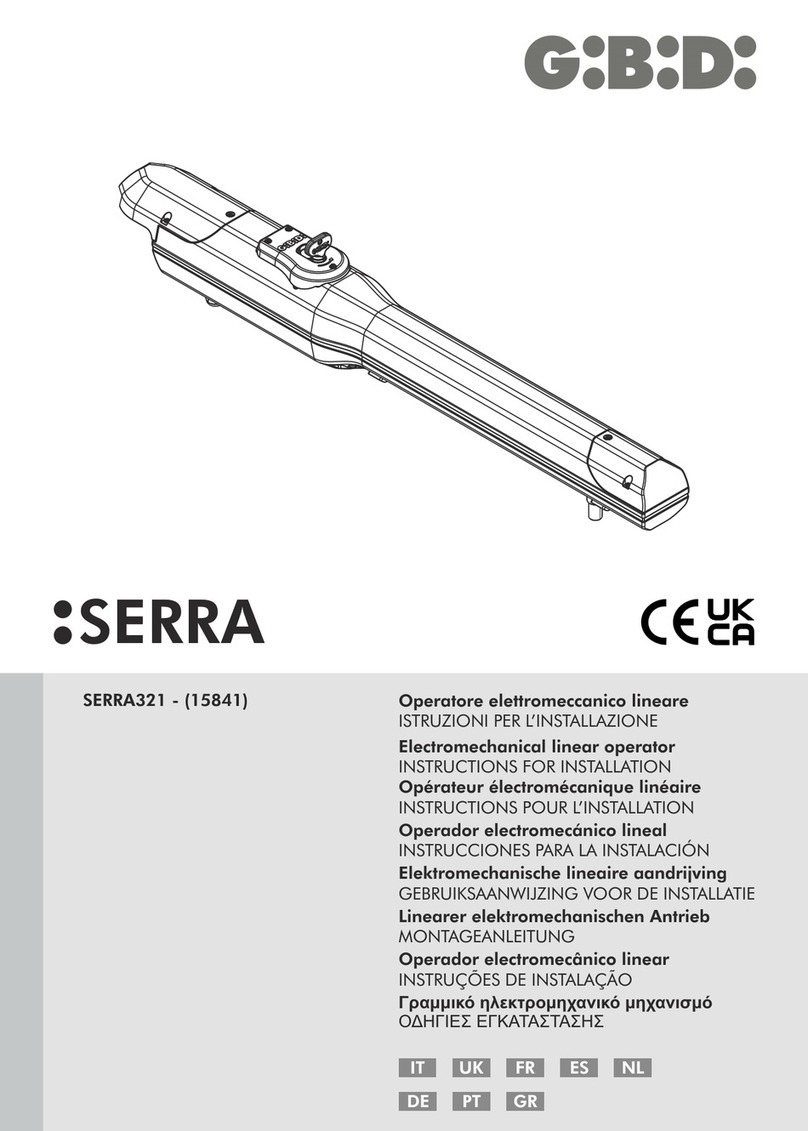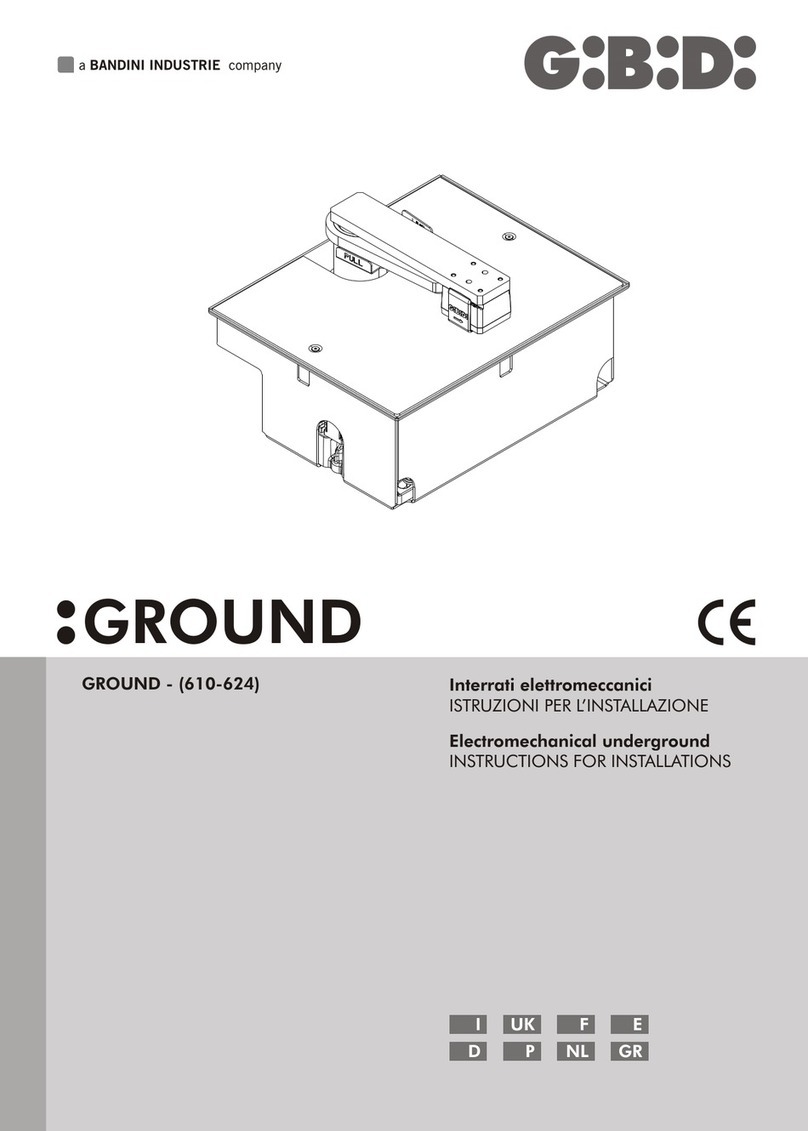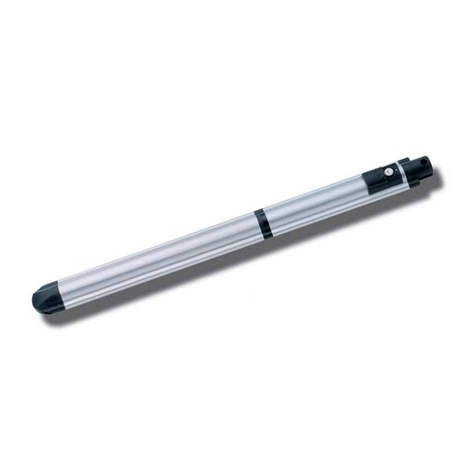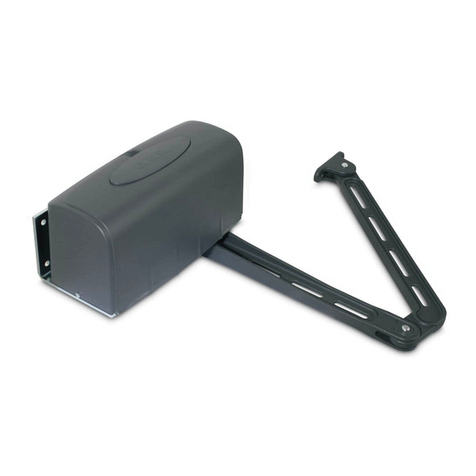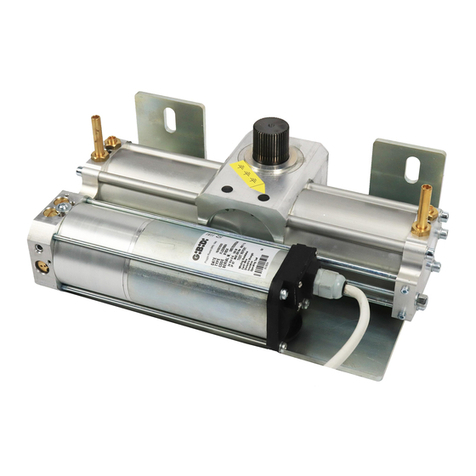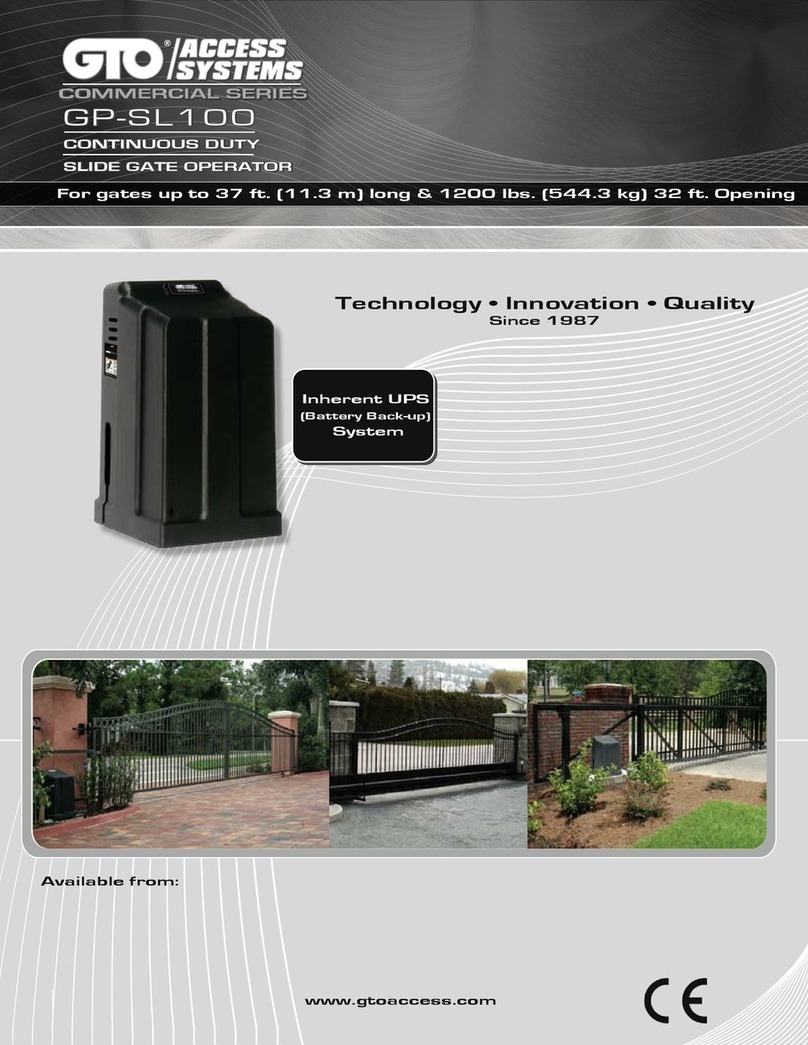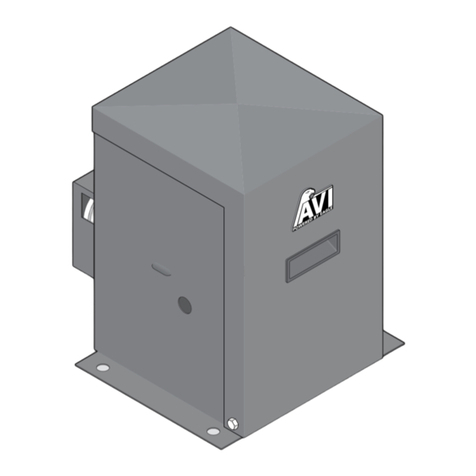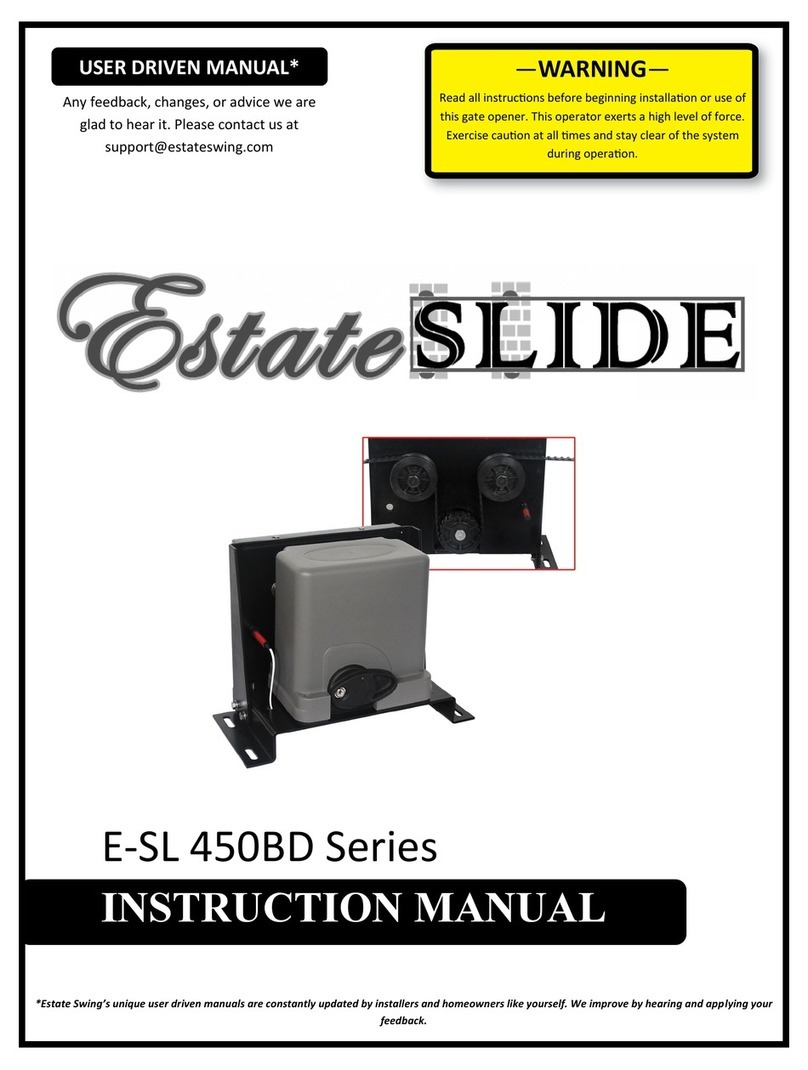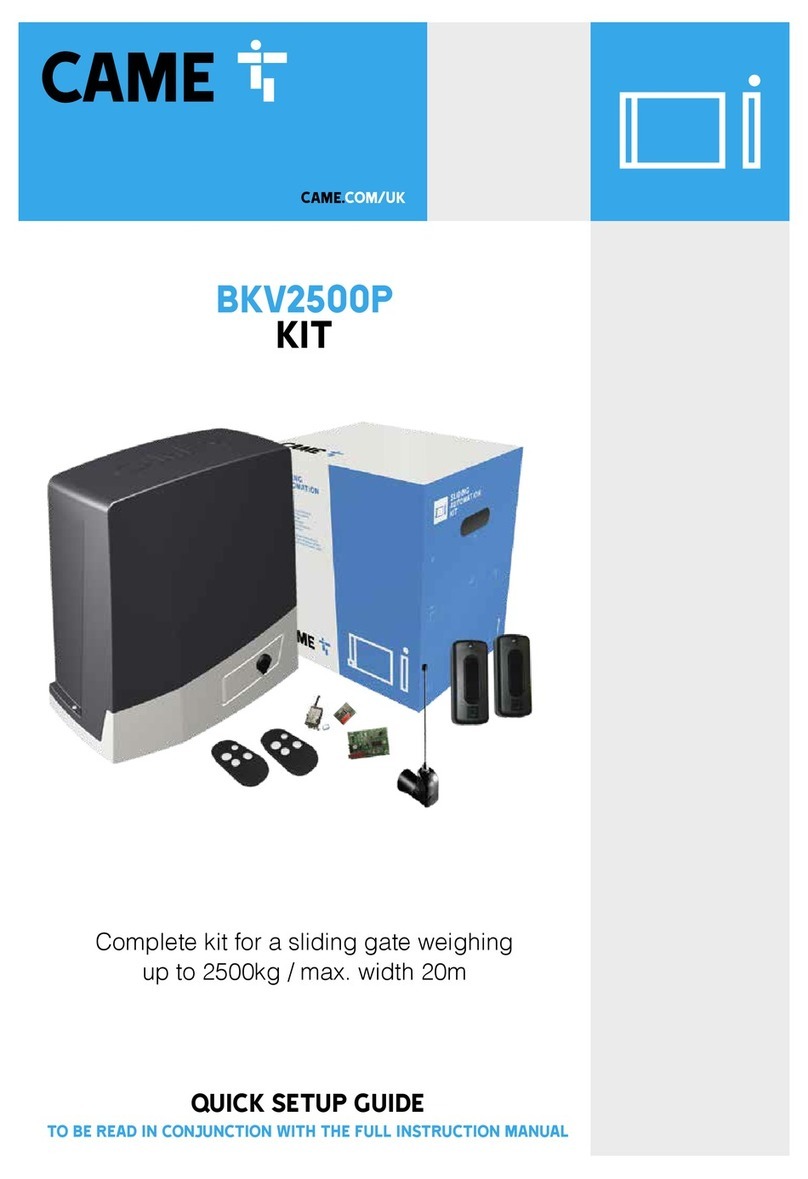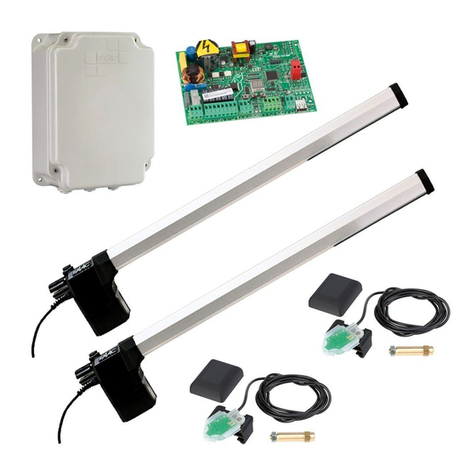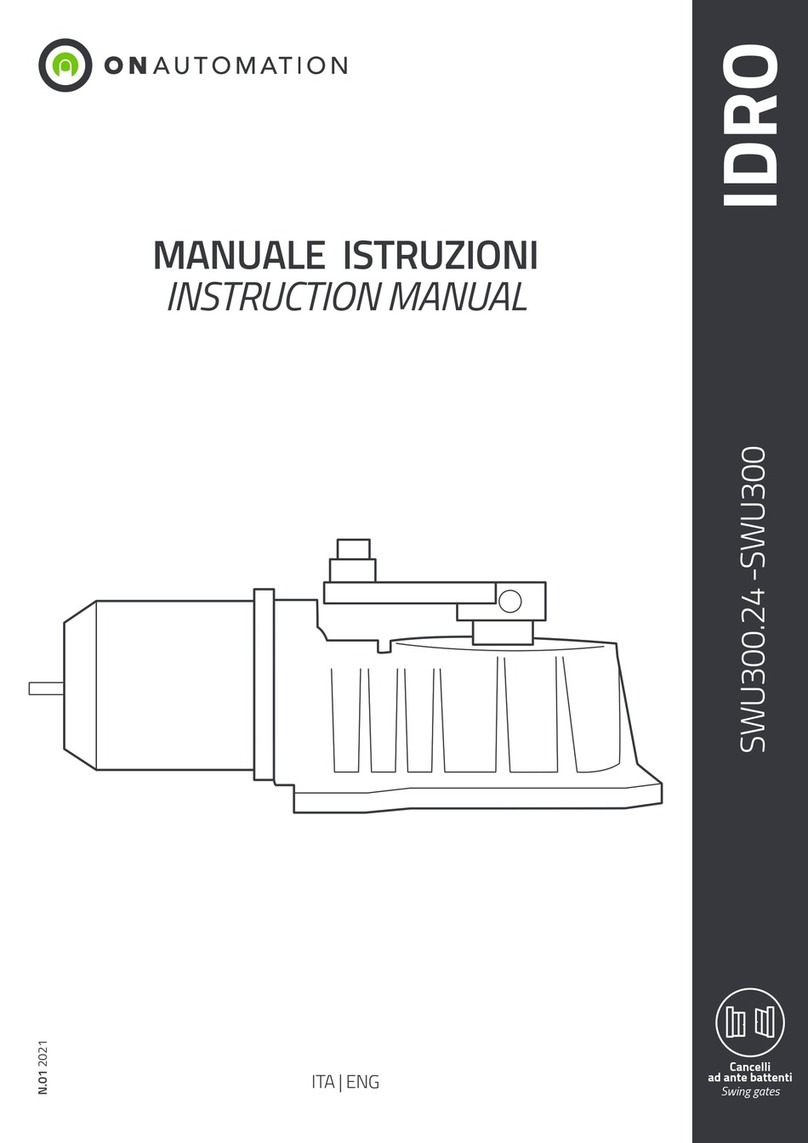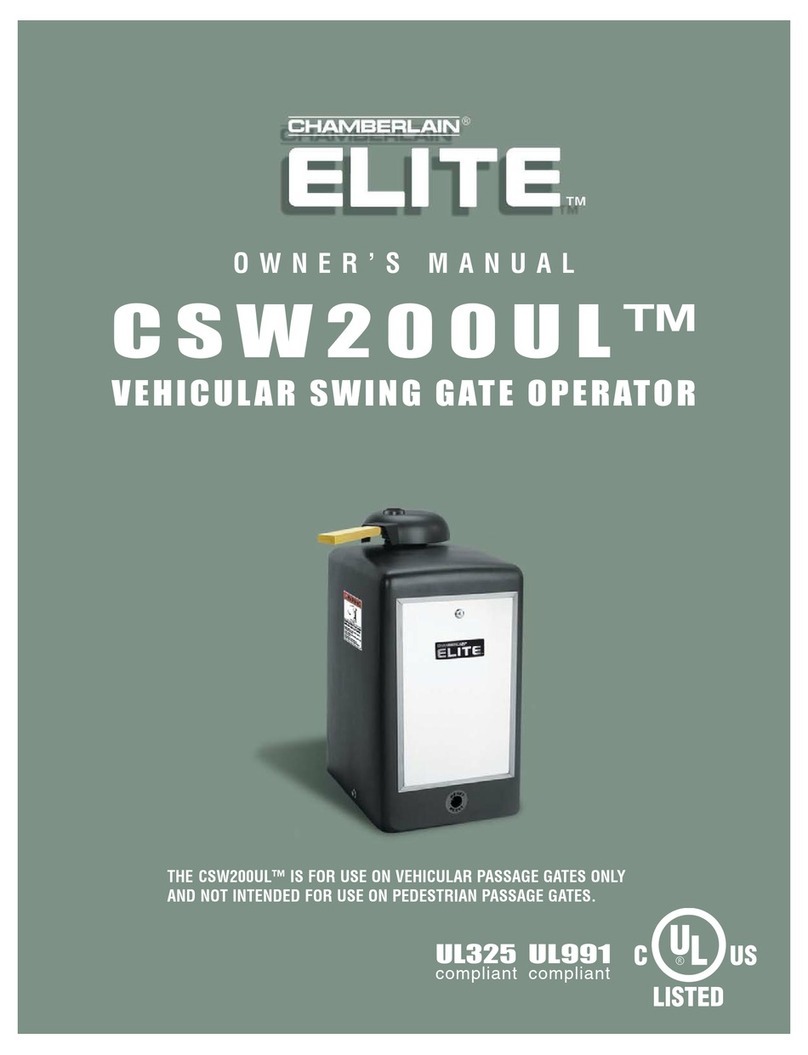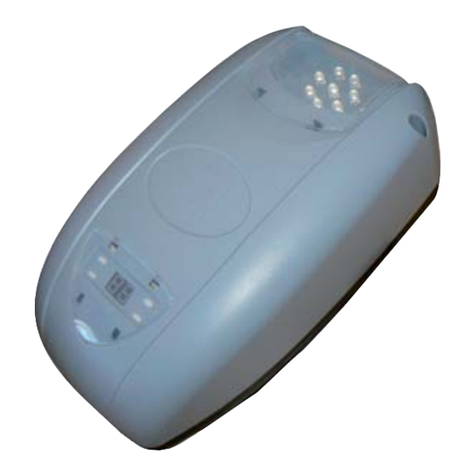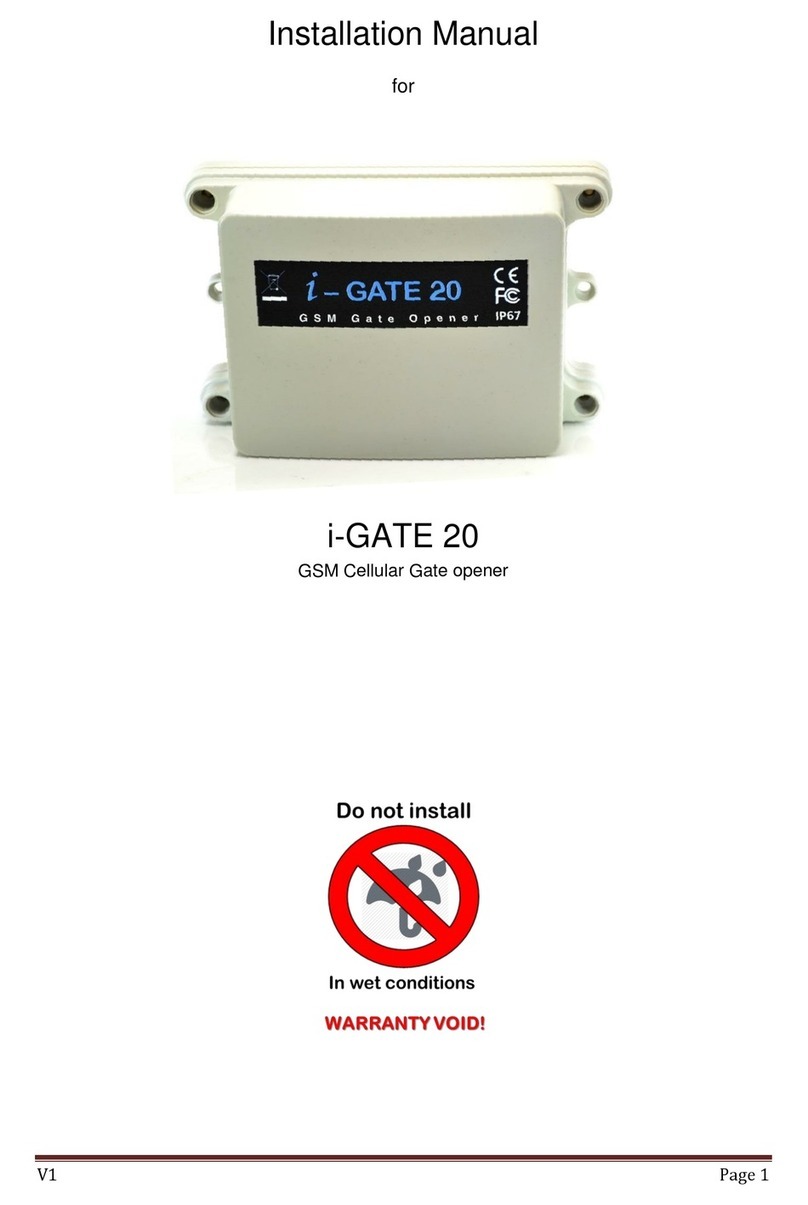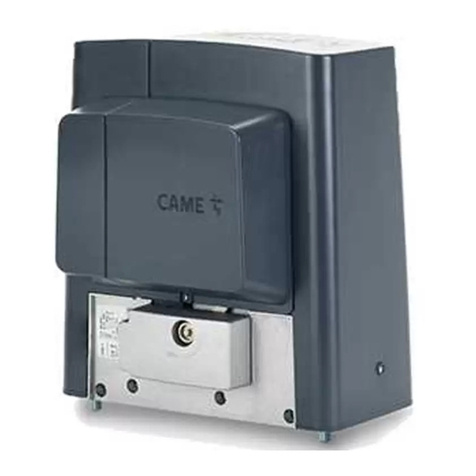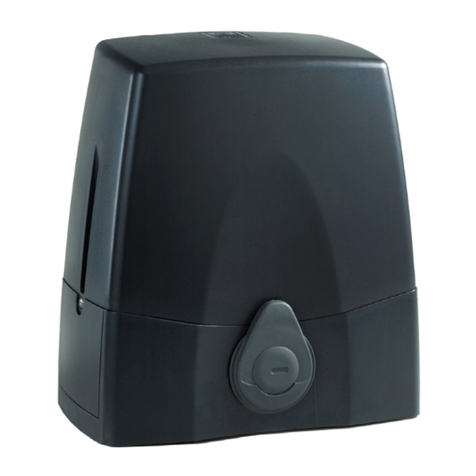GiBiDi F12E Guide

F12E
www.gibidi.com
ISTRUZIONI PER L’INSTALLAZIONE
INSTRUCTIONS FOR INSTALLATION
INSTRUCTIONS POUR L’INSTALLATION
ANLEITUNG FÜR ZUR INSTALLATION
INSTRUCCIONES PARA LA INSTALLACION
INSTRUÇÕES PARA A INSTALAÇAO
INSTRUCTIES VOOR DE INSTALLATIE
AUTOMATISMI PROFESSIONALI PER CANCELLI E GARAGE
T

Italiano
2
AUTOMATISMI PROFESSIONALI PER CANCELLI E GARAGE

AUTOMATISMI PROFESSIONALI PER CANCELLI E GARAGE
Italiano
3
Alimentazione 230Vca monofase 50 /60 Hz
N° motori 2 x 12Vcc 30W (cod. AS04330)
2 x 12Vcc 60W (cod. AS04340)
Lampeggiante 12Vcc 15W Max
Alim. Fotocellule 12Vcc 6W Max (2 coppie di foto)
Elettroserratura 12Vcc 15W Max
Temperatura di utilizzo -20 ÷ +60°C
Tempo di pausa 0 ÷ 240 s
Tempo di lavoro 0 ÷ 240 s
Prelampeggio fisso 2 s
L’apparecchiatura elettronica cod. AS04330 e cod. AS04340, prevista per la gestione di 1 o 2 motori 12 Vcc per cancelli a battente è conforme
ai sensi delle Direttive vigenti
Funzioni disponibili: - passo-passo
- passo-passo con richiusura automatica (residenziale)
- condominiale
- apertura pedonale con secondo canale telecomando solo con MODULO RADIO cod. AU01780)
- colpo d’ariete
- rallentamenti
- chiusura automatica dopo aver liberato le fotocellule
Regolazioni: - tempo lavoro
- tempo pausa
- tempo sfasamento ante
- soglie amperometriche
Generalità
Collegamenti (Legenda morsettiere)
CARATTERISTICHE TECNICHE
1Ingresso FOTOCELLULE (N.C.) 11 - 12 Uscita motore 2 (12 positivo in apertura)
2Ingresso STOP, (N.C). Provoca un arresto funzionale
del moto (NON DI SICUREZZA) 13 - 14 Uscita motore 1 (= apre per primo) da utilizzare
anche per anta pedonale (14 positivo in apertura)
3Ingresso START (N.A.) 15 Massa ANTENNA
4COMUNE per STOP-START-FOTOCELLULE 16 Segnale ANTENNA
CN2-
CN3 Ingresso 12Vac (dal trasformatore)
CN4 -
CN5 (*)
Ingresso per BATTERIA TAMPONE 12Vcc
(CN4 = positivo)
F - N Alimentazione 230 Vac monofase 50/60 Hz
7 - 8 Uscita 12 Vcc per alimentazione ELETTROSERRATURA
(Max15W)
5 - 6 Uscita 12Vcc per alimentazione max 2 coppie
di FOTOCELLULE (6 = POSITIVO)
9 - 10 Uscita 12 Vcc per LAMPEGGIANTE (Max. 15 W)
A) Prima di procedere con l’installazione bisogna predisporre a monte dell’impianto un interruttore magneto termico o differenziale con
portata massima 10A. L’interruttore deve garantire una separazione omnipolare dei contatti, con distanza di apertura di almeno 3 mm
B) Per evitare possibili interferenze, differenziare e tenere sempre separati i cavi di potenza (sezione minima 1,5mm2) dai cavi dei segnale
che devono essere almeno da 0,5mm2.
C) Eseguire i collegamenti facendo riferimento alla tabella seguente e alla serigrafia allegata. Fare molta attenzione a collegare in serie tutti
i dispositivi che vanno collegati allo stesso ingresso N.C. (normalmente chiuso) e in parallelo tutti i dispositivi che condividono lo stesso
ingresso NA (normalmente aperto).
Una errata installazione o un uso errato del prodotto può compromettere la sicurezza dell’impianto.
D) Tutti i materiali presenti nell’imballo non devono essere lasciati alla portata dei bambini in quanto, potenziali fonti di pericolo.
E) Il costruttore declina ogni responsabilità ai fini del corretto funzionamento dell'automazione nel caso non vengano utilizzati i componenti
e gli accessori di propria produzione e idonei per l'applicazione prevista.
F) Al termine dell’istallazione verificare sempre con attenzione il corretto funzionamento dell’impianto e dei dispositivi utilizzati.
AVVERTENZE PER L’INSTALLAZIONE
(*) ATTENZIONE:
IN CASO DI UTILIZZO CON BATTERIA E’ NECESSARIO L’ACCESSORIO “ CAVO OPTIONAL” APPOSITAMENTE PREVISTO PER LA RICARICA.
IL COLLEGAMENTO DI UNA BATTERIA SENZA L’APPOSITO CAVO PUÒ PROVOCARE DANNI IRREPARABILI ALL’APPARECCHIATURA.

Italiano
4
AUTOMATISMI PROFESSIONALI PER CANCELLI E GARAGE
4
3
SELEZIONE FUNZIONI TRAMITE DIP-SWITCH SW1
La tabella che segue indica cosa succede ad ogni COMANDO START in funzione del programma selezionato e dello stato in cui si trova il
cancello in quel momento.
(*) IMPOSTAZIONI DI DEFAULT
Ruotando i trimmer in senso orario aumenta la SOGLIA AMPEROMETRICA di blocco del rispettivo motore. (da 2,5 a 5,5 A ).
L’intervento dell’amperometrica sia in apertura che in chiusura provoca l’arresto immediato del movimento.
IMPOSTAZIONI DI DEFAUL: trimmer regolati a metà della loro corsa.
REGOLAZIONE TRIMMER PT1 (motore 1) e PT2 (motore 2)
Se all’apparecchiatura viene abbinato il ricevitore cod. AU01780 è possibile gestire anche l’apertura parziale della sola ANTA1 (ciclo pedonale)
utilizzando il 2° canale del telecomando (precedentemente memorizzato).
Per eseguire la programmazione del CICLO PEDONALE si opera come sopra descritto (passi 1, 2, 3, 5, 6, 7, 8) ma occorre impartire il
comando mediante il 2° CANALE del telecomando.
DIP ON OFF
Abilitazione Colpo di Ariete per facilitare lo sgancio
dell’elettroserratura
Programma –PASSO-PASSO (*)
Programma CONDOMINIALE
Fase di RALLENTAMENTO negli ultimi secondi
di ogni manovra (*)
2
(Solo con Dip 1 OFF)
1
Colpo d’ariete disabilitato (*)
Programma RESIDENZIALE
(passo-passo con richiusura automatica)
Ininfluente (vedere DIP2) (*)
RALLENTAMENTI disabilitati
6
5
Esclusione ingresso fotocellule (morsetti 1-4) (*)
PROGRAMMAZIONE TEMPI
Ingresso fotocellule abilitato
Funzionamento normale (*)
CONDOMINIALE
PROGRAMMA
selezionato Il cancello è
CHIUSO
APRE
APRE
APRE
RESIDENZIALE
PASSO-PASSO
Il cancello sta
APRENDO
ARRESTA e abilita il
conteggio del tempo
pausa per la successiva
richiusura automatica.
ARRESTA
IGNORATO
Il cancello è
APERTO
CHIUDE (il cancello
chiuderebbe automatica-
mente al termine del
tempo pausa)
CHIUDE
Reinizializza il
conteggio tempo pausa
al termine del quale
chiude automaticamente
Il cancello sta
CHIUDENDO
ARRESTA E RIAPRE
ARRESTA
ARRESTA E RIAPRE
ATTENZIONE:
Con DIP 2 OFF, se durante l’apertura, la chiusura oppure in pausa viene a mancare tensione, al ritorno dell’alimentazione l’apparecchiatura
comanda automaticamente una manovra di chiusura totale del cancello .
ATTENZIONE:
Per facilitare la fase di PROGRAMMAZIONE fare apprendere un telecomando alla centrale o alla ricevente (vedere APPRENDIMENTO CODICI)
altrimenti è necessario impartire il comando START tramite chiusura del contatto ai morsetti 3-4.
Iniziare la programmazione partendo dalla condizione di CANCELLO COMPLETAMENTE CHIUSO.
Per abilitare i rallentamenti porre il Dip 3 in ON prima di iniziare la programmazione.
(tempo lavoro, tempo pausa, tempo sfasamento ante, ciclo pedonale)
1) CANCELLO CHIUSO: posizionare il DIP5 in “ON”.
2) Premere START: parte in apertura l’Anta 1 e dopo 2 secondi anche l’anta 2.
3) Quando l’Anta 1 arriva contro il fermo meccanico si arresta da sola. L’ANTA 1 SI FERMA.
4) Quando l’Anta 2 arriva contro il fermo meccanico si arresta da sola. L’ANTA 2 SI FERMA.
5) Si spegne il lampeggiante e inizia il conteggio tempo pausa.
5) Al termine del tempo desiderato (max 240 s) premere START: L’ANTA 2 PARTE IN CHIUSURA.
6) Attendere il tempo necessario per garantire lo sfasamento ante desiderato quindi premere START: L’ANTA 1 PARTE IN CHIUSURA.
7) La centrale non accetta altri comandi fino all’ARRESTO DELLE ANTE contro i rispettivi fermi meccanici di chiusura. CANCELLO CHIUSO.
8) Riportare il DIP 5 in OFF per terminare la programmazione.
PROGRAMMAZIONE TEMPI – Cancello a 2 Ante

AUTOMATISMI PROFESSIONALI PER CANCELLI E GARAGE
Italiano
5
Questa funzione consente di ridurre il tempo di pausa a soli 4 secondi dall’intervento e successiva liberazione delle fotocellule.
Per abilitare la funzione procedere nel seguente modo. Durante la programmazione tempi (passo 5), quando il cancello è in pausa,
oscurare le fotocellule per almeno tre secondi. Il lampeggiante inizia a lampeggiare per segnalare l’ avvenuta memorizzazione della funzione.
Liberare le fotocellule, attendere il tempo di pausa desiderato e concludere regolarmente la fase di programmazione tempi.
Per escludere la funzione ripetere la procedura di programmazione senza oscurare le fotocellule.
FUNZIONE RICHIUSURA RAPIDA
(tempo lavoro, tempo pausa).
Prima di procedere alla programmazione tempi è necessario impostare l’apparecchiatura per la gestione di un solo motore.
1) CANCELLO CHIUSO : posizionare il DIP5 in “ON”
Premere il tasto P1: il led DL1 lampeggia 2 volte (premendolo nuovamente lampeggerebbe una sola volta per indicare l’impostazione
relativa ad un cancello a 2 Ante).
Eseguire la programmazione tempi rispettando la stessa logica sopra descritta ( passi 2, 3, 5, 6, 7, 8).
PROGRAMMAZIONE TEMPI – Cancello ad 1 Anta
Per avere il lampeggiante acceso intermittente anche durante il tempo pausa, nella fase 5 di programmazione tempi è necessario
premere il secondo tasto del telecomando (precedentemente appreso).
GESTIONE LAMPEGGIANTE IN PAUSA (solo se utilizzato MODULO RADIO cod AU01780)
Se sull’apparecchiatura si utilizza il modulo radio cod. AU01780 la decodifica del segnale trasmesso viene fatta direttamente dalla centrale,
la quale è in grado di decodificare segnali Rolling- code a frequenza 433.92MHz.
Per l’autoapprendimento dei telecomandi e per l’eventuale cancellazione totale della memoria fare riferimento a quanto segue.
Apprendimento codici (max 200).
Alimentando per la prima volta l’ Apparecchiatura, si verifica che il led DL1 emette un breve lampeggio.
Premere il pulsante P1: il led DL1 si accende fisso ad indicare che il ricevitore è pronto per apprendere un codice.
Premere un tasto del Trasmettitore (Tasto n°2 solo per START PEDONALE): il led DL1 emette un lampeggio per l’avvenuta memorizzazione.
Non occorre premere nuovamente il tasto P1 per memorizzare altri telecomandi uno di seguito all’altro.
Lo spegnimento spontaneo del LED DL1 indica che il sistema è uscito dalla fase di apprendimento ed è pronto per funzionare regolarmente.
Cancellazione totale della memoria
Per eseguire la cancellazione totale dei codici memorizzati premere il pulsante P1 (il led DL1 si accende) e mantenerlo premuto sino allo
spegnimento del led DL1.
Al rilascio del pulsante il led emette un lampeggio per segnalare che la memoria codici è vuota.
MODULO RADIO
Prima di dare tensione
- Verificare la corretta impostazione dei dip-switch.
- Verificare i collegamenti elettrici. Collegamenti errati potrebbero danneggiare irreversibilmente l’apparecchiatura o risultare pericolosi per
- l’operatore o l’utilizzatore.
VERIFICHE FINALI E COLLAUDO
- Verificare che i LED rossi (DL3, DL 4) siano normalmente accesi e il Led giallo (DL2) sia spento.
- Verificare che gli eventuali dispositivi di rilevazione collegati ai morsetti 1-4 funzionano correttamente.
- Verificare che il cancello sia chiuso e che i motori siano pronti per il funzionamento.
- Rimuovere eventuali ostacoli nel raggio d’azione del cancello.
ALIMENTARE IL DISPOSITIVO
IMPORTANTE: Nel caso di utilizzo con altro tipo di ricevitore fare riferimento alle relative istruzioni.
Il costruttore non può considerarsi responsabile per eventuali danni causati da uso improprio e/o irragionevole.
La Gi.Bi.Di. si riserva il diritto, in qualsiasi momento e senza preavviso alcuno, di apportare modifiche ispirate al miglioramento del prodotto.
Risoluzione anomalie
L’operatore non apre o non richiude
Verificare che i led rossi siano accesi e quello giallo sia spento.
Collegare l’ingresso STOP (morsetti 2-4) ad un pulsante N.C. o ponticellarlo.
Collegare l’ingresso START ( morsetti 3-4 ) ad un pulsante N.A.
ANOMALIE POSSIBILI CAUSE e SOLUZIONI
Il trasmettitore ha poca portata
Controllare che l’antenna sia posizionata correttamente (calza morsetto 15 segnale morsetto
16 per apparecchiature cod. AS04330) .
Se utilizzato ricevitore a innesto (cod. AU01710) l’antenna va collegata ai morsetti presenti sul
ricevitore.
Controllare che nelle vicinanze non siano presenti fonti di disturbo che limitano la portata.
Le fotocellule non funzionano Dip 6 ON. Portare dip 6 OFF e verificare che si spegne il led DL4 quando vengono oscurate
le fotocellule.
Premendo il 2° tasto del tx non si
attiva il pedonale
Il secondo canale del trasmettitore non è stato precedentemente appreso.
Eseguire la procedura di apprendimento del secondo canale.
AVVERTENZE
Mentre si esegue il cablaggio e/o l’inserimento del MODULO RADIO l’apparecchiatura non deve essere alimentata. L’impiego di questa
apparecchiatura deve attenersi rigorosamente alle indicazioni fornite dal costruttore pena l’annullamento degli estremi di garanzia.
L’installazione e/o la manutenzione deve essere eseguita solo da personale qualificato e nel rispetto delle disposizioni legislative Vigenti.
Attenzione:
prima di eseguire qualsiasi intervento (installazione o manutenzione) assicurarsi di aver staccato l’alimentazione!!

Italiano
6
AUTOMATISMI PROFESSIONALI PER CANCELLI E GARAGE
DICHIARAZIONE DI CONFORMITA’ CE
Il fabbricante:
Gi.Bi.Di Continental S.p.A
Sede Legale:
Via B.Bonomi, 17 Fraz. Toline 25055 Pisogne (BS)
Sede Amministrativa:
Ufficio Commerciale:
Stabilimento:
Via Abetone Brennero,177/B
46025 Poggio Rusco (Mantova) ITALY
Dichiara che il prodotto
APPARECCHIATURA ELETTRONICA F12E
Sono conformi alle seguenti direttive CEE:
• Direttiva Bassa Tensione 73/23 e successive modifiche
• Direttiva Compatibilità Elettromagnetica 89/336 e successive modifiche
• Direttiva R&TTE 99/05
E che sono state applicate le seguenti (parti/clausole) di norme armonizzate:
EN60335-1, EN300 220-3, EN301 489-1, EN301 489-3,
EN61000-3-2, EN61000-3-3, EN61000-6-3, EN61000-6-1
Pisogne, li 01/09/2003
Amministratore Delegato
Gualeni Dario

PROFESSIONAL AUTOMATIC SYSTEM FOR GATES AND GARAGEDOORS
English
7
Power supply 230 VAC, single-phase, 50 /60 Hz
No. of motors 2 x 12 VDC 30W (code AS04330 )
2 x 12 VDC 60W (code AS04340)
Flashlight 12 VDC 15W max.
Photocell power supply 12 VDC 6W max. (2 pairs of photocells)
Electric lock 12 VDC 15W max.
Operating temperature -20 to +60°C
Pause Time 0 - 240 s
Run time 0 - 240 s
Fixed pre-flashing 2 s
The electronic control unit code AS04330 and AS04340 for control of one or two 12 VDC motors for swing gates is in conformity with the Directives
in force.
Functions available: - step-by-step
- step-by-step with automatic reclosing (residential)
- condominium
- pedestrian opening with second remote control channel (only with RADIO MODULE code AU01780)
- water hammer
- deceleration
- automatic closing after freeing the photocells
Adjustments : - run time
- pause time
- gate phase shift time
- amperometric thresholds
General
Connections (Terminal Board Legend)
TECHNICAL CHARACTERISTICS
1PHOTOCELL input (NC) 11 - 12 Output Motor 2 ( 12 positive during opening )
2STOP input (NC). Causes a functional stop of the
motion (NOT A SAFETY STOP) 13 - 14 Output Motor 1 (= it opens for first) to be used for
pedestrian gate (14 positive during opening)
3START input (NO) 15 ANTENNA ground
4COMMON for STOP-START-PHOTOCELLS 16 ANTENNA signal
CN2-
CN3 12 VAC input (from transformer)
CN4 -
CN5 (*)Input for 12 VDC BUFFER BATTERY (CN4 = positive)
F - N Power supply, 230 VAC, single-phase, 50/60 Hz
7 - 8 12 VDC output for ELECTRIC LOCK power supply
(max. 15 W)
5 - 6 12 VDC output for power supply, max. 2 pairs of
photocells (6 = POSITIVE)
9 - 10 12 VDC output for FLASHLIGHT ( max. 15 W )
A) Before proceeding with installation, fit a magnetothermal or differential switch with maximum capacity of 10A upstream of the system.
The switch must guarantee omnipolar separation of the contacts with an opening distance of at least 3 mm.
B) To prevent possible interference, differentiate and always keep the power cables (minimum cross-section 1.5 mm2) separate from the
signal cables which must be at least 0.5 mm2.
C) Make the connections referring to the following table and the attached silk-screen print. Be very careful to connect in series all the
devices that are connected to the same NC (normally closed) input and in parallel all the devices that share the same NO (normally open)
input.
Incorrect installation and improper use of the product may compromise the safety of the system.
D) All the material contained in the package must be kept out of reach of children, since they constitute a potential hazard.
E) The manufacturer declines all responsibility for proper functioning of the automated device if original Gi-Bi-Di components and accessories
suitable for the application are not used.
F) After installation always carefully check proper functioning of the system and the devices used.
WARNINGS
(*) WARNING:
IF USING WITH BATTERY, THE “OPTIONAL CABLE” ACCESSORY SPECIFICALLY DESIGNED FOR RECHARGING IS REQUIRED.
CONNECTING A BATTERY WITHOUT THIS SPECIAL CABLE MAY CAUSE IRREPARABLE DAMAGE TO THE CONTROL UNIT.

English
8
PROFESSIONAL AUTOMATIC SYSTEM FOR GATES AND GARAGEDOORS
4
3
FUNCTION SELECTION VIA DIP-SWITCH SW1
The following table shows what occurs each time a START COMMAND is given depending on the program selected and the state in which
the gate is at that moment.
(*) DEFAULT SETTINGS
Turning the trimmers clockwise increases the AMPEROMETRIC LOCKING THRESHOLD of the respective motor (2.5 to 5.5 A).
The intervention of the current limiter both during opening and closing causes an immediate stop of the movement.
DEFAULT SETTINGS: trimmers adjusted to half their stroke.
ADJUSTING THE TRIMMERS PT1 (motor 1) and PT2 (motor 2)
If the control unit is coupled to the receiver code AU01780 it is also possible to control partial opening of only WING 1 (pedestrian cycle) using
the 2nd channel of the remote control (previously stored).
To program the PEDESTRIAN CYCLE operate as described above (steps 1, 2, 3, 5, 6, 7, 8), but give the command through the 2nd CHANNEL of
the remote control.
DIP ON OFF
Water Hammer enable to facilitate electric lock release
STEP-BY-STEP program (*)
CONDOMINIUM program
DECELERATION phase in the last seconds of each
manoeuvre (*)
2
(Only with DIP1 OFF)
1
Water Hammer disabled (*)
RESIDENTIAL program
(step-by-step with automatic reclosing)
Uninfluential (see DIP2) (*)
DECELERATION disabled
6
5
PHOTOCELL input disabled (terminals 1-4) (*)
TIME PROGRAMMING
PHOTOCELL input enabled
Normal operation (*)
CONDOMINIUM
PROGRAM
selected The gate is
CLOSED
OPENS
OPENS
OPENS
RESIDENTIAL
STEP-BY-STEP
The gate is
OPENING
STOPS and enables
counting of the pause
time for the next
automatic reclosing
STOPS
IGNORED
The gate is
OPEN
CLOSES
(the gate would close
automatically at the end
of the pause time)
CLOSES
Reinitialises counting of
the pause time at the
end of which it closes
automatically
The gate is
CLOSING
STOPS AND RE-OPENS
STOPS
STOPS AND RE-OPENS
WARNING:
With DIP2 OFF: should the power fail during opening, closing or pause, when the power is restored the control unit automatically performs a full
closing manoeuvre of the gate.
WARNING !
To facilitate the PROGRAMMING phase, let the control unit or the receiver learn a remote control (see CODE LEARNING), otherwise the START
command must be given by closing the contact to the terminals 3-4.
Start programming from the condition in which the GATE IS COMPLETELY CLOSED.
To enable deceleration set DIP3 to ON before starting to program.
(run time, pause time, gate phase shift time, pedestrian cycle)
1) GATE CLOSED: set DIP5 to ON.
2) Press START: Wing 1 starts opening and after 2 seconds also Wing 2.
3) When Wing 1 arrives against the mechanical stop, it stops automatically. WING 1 STOPS.
4) When Wing 2 arrives against the mechanical stop, it stops automatically. WING 2 STOPS.
5) The flashlight goes off and counting of the pause time starts. After the desired time (max. 240 s) press START: WING 2 STARTS CLOSING.
6) Wait for the time necessary to assure the desired gate phase shift and then press START: WING 1 STARTS CLOSING.
7) The control unit does not accept any more commands until the WINGS HAVE STOPPED against the respective mechanical closing stops.
7) GATE CLOSED.
8) Set DIP5 to OFF to finish programming.
TIME PROGRAMMING – double swing gates

PROFESSIONAL AUTOMATIC SYSTEM FOR GATES AND GARAGEDOORS
English
9
This function allows reducing the pause time to only 4 seconds from intervention and subsequent freeing of the PHOTOCELLS.
To enable the function, proceed as follows: during time programming (step 5) when the gate is in pause, black out the PHOTOCELLS for
at least three seconds. The flashlight starts flashing to signal that the function has been stored. Free the PHOTOCELLS, wait for the
desired pause time and finish the time programming phase as normal. To disable the function, repeat the programming procedure without
blacking out the PHOTOCELLS.
FAST CLOSING FUNCTION
( run time, pause time)
Before proceeding with time programming, the control unit must be set for control of only one motor.
1) GATE CLOSED: set DIP5 to ON.
Press the button P1: the LED DL1 flashes twice (pressing it again, it would flash once only to indicate double swing gate setting).
Program the times respecting the same logic described above (steps 2, 3, 5, 6, 7, 8).
TIME PROGRAMMING – single swing gate
For the flashlight to come on intermittently also during the pause time, press the second key of the remote control (previously learned)
during step 5 of time programming.
CONTROLLING THE FLASHLIGHT IN PAUSE TIME (only if using the RADIO MODULE code AU01780)
If the radio module code AU01780 is used on the control unit, the signal transmitted is directly decoded by the control unit which is able
to decode rolling-code signals at a frequency of 433.92MHz.
For self-learning of the remote controls and complete memory reset refer to the following:
Code learning (max. 200)
When powering the control unit the first time, the LED DL1 emits a brief flash.
Press the button P1: the LED DL1 comes on fixed to indicate that the receiver is ready to learn a code.
Press a key of the transmitter (Key 2 only for PEDESTRIAN START): the LED DL1 flashes once to indicate that the code has been stored.
The button P1 does not have to be pressed again to store other remote controls one after the other.
When the LED DL1 goes off, it indicates that the system has exited the learning phase and is ready to function regularly.
Total memory reset
To delete all the codes stored, press the button P1 (the LED DL1 comes on) and hold it down until the LED DL1 goes off.
When the button is released, the LED flashes once to signal that the code memory is empty.
RADIO MODULE
Before powering the control unit:
- Check proper setting of the dip switches.
- Check the electrical connections. Improper connections may irreversibly damage the control unit or present a hazard to the operator or the user.
FINAL CHECKS AND TESTING
- Check that the red LEDs (DL3, DL 4) are normally on and that the yellow LED (DL2) is off.
- Check that any detection devices connected to terminals 1-4 function properly
- Check that the gate is closed and that the motors are ready for operation.
- Remove any obstacles within the range of action of the gate.
POWER THE DEVICE
IMPORTANT: If using another type of receiver, refer to the relevant instructions.
The manufacturer cannot be held responsible for damage caused by improper and/or irrational use.
Gi.Bi.Di. reserves the right to make modifications at any time and without prior notice in order to improve the product.
TROUBLESHOOTING
The operator does not open or reclose
Check that the red LEDs are on and the yellow one off.
Connect the STOP input (terminals 2-4) to an NC button or jumper it.
Connect the START input (terminals 3-4) to an NO button.
FAULT POSSIBLE CAUSES and SOLUTIONS
The transmitter has little range
Check that the antenna has been positioned properly (braid terminal 15, signal terminal 16,
for control units code AS04330).
If a plug-in receiver is used (code AU01710), the antenna must be connected to the terminals
on the receiver.
Check that there are no sources of disturbance in the vicinity, which limit the range.
The PHOTOCELLS do not work DIP6 ON. Set DIP6 to OFF and check that the LED DL4 goes off when the photocells are
blacked out.
Pressing the 2nd key of the TX the
pedestrian gate is not activated
The second channel of the transmitter has not been learned previously.
Perform the learning procedure of the second channel.
WARNINGS
When wiring or inserting the RADIO MODULE, the control unit must not be powered.
The control unit must be used strictly following the instructions provided by the manufacturer on pain of forfeiture of the guarantee.
Installation and/or maintenance must be carried out by qualified personnel in compliance with the provisions of the laws in force.
Warning:
Before carrying out any operation (installation or maintenance) ensure that the power has been cut !!

English
10
PROFESSIONAL AUTOMATIC SYSTEM FOR GATES AND GARAGEDOORS
DECLARATION OF CONFORMITY EC
The manufacturer:
Gi.Bi.Di Continental S.p.A
Registered office:
Via B.Bonomi, 17 Fraz. Toline 25055 Pisogne (BS)
Administrative office:
Sales offices:
Factory:
Via Abetone Brennero, 177/B
46025 Poggio Rusco (Mantova) ITALY
It declares that the product
F12E ELECTRONIC EQUIPMENT
Are in conformità with the regulations of the following EEC directives:
• Directive Low Tension 73/23 and following changes
• Directive Electromagnetic Compatibility 89/336 and following changes
• Directive R&TTE 99/05
He following (part/clauses of) harmonised regulations heve been applied:
EN60335-1, EN300220-3, EN301489-1, EN301489-3,
EN61000-3-2, EN61000-3-3, EN61000-6-3, EN61000-6-1
Pisogne, them 01/09/2003
Managing Director
Gualeni Dario

AUTOMATISMES PROFESSIONNELS POUR PORTES ET PORTAILS
Français
11
Alimentation 230 Vca monophase 50/60 Hz
N° moteurs 2 x 12Vcc 30W (cod. AS04330)
2 x 12Vcc 60W (cod. AS04340)
Clignoteur 12 Vcc - 15Wmax
Alim. Photocellules 12 Vcc 6 W max (2 couples de photocellules)
Electroserrure 12 Vcc - 15 W max
Température d’utilisation 20 +60 °C
Temps pause 0 ÷ 240s.
Temps travail 0 ÷ 240 s
Preclignotement 3 sec. (fixe)
Les appareillages électroniques codes AS04330 et AS04340 est prévue pour la gestion de 1 ou 2 moteurs 12 Vcc pour por tails battants et est
conforme aux termes des Directives en vigueur.
Fonctionnements disponibles: - pas-pas
- pas-pas avec réenclenchement automatique (résidentiel)
- en copropriété
- ouverture piétonnière avec seconde canal télécommande (seulement avec module radio code AU01780)
- coup de bélier
- ralentissements
- fermeture automatique depuis d’avoir livré les photocellules
Régulations: - temps travail
- temps pause
- temps déphasage portes
- seuils ampèrométriques
GENERALITES
BRANCHEMENTS (LEGENDE PLAQUES A BORNES)
CARACTERISTIQUES TECHNIQUES
1Entrée PHOTOCELLULES (N.C.) 11 - 12 Sortie moteur 2 (12 positif en ouverture)
2Entrée STOP, (N.C) . Cause un arrêt fonctionnel du
mouvement ( PAS DE SURETE ) 13 - 14 Sortie moteur 1 (= il ouvre pour premier) à utiliser
pour porte piétonnière (14 positif en ouverture)
3Entrée START (N.A.) 15 Masse ANTENNE
4COMMUN pour STOP-START-PHOTOCELLULES 16 Signal ANTENNE
CN2-
CN3 Entrée pour batterie tampon 12Vcc (CN4 = positif)
CN4 -
CN5 (*)Entrés 12Vac (du transformateur)
F - N Alimentation 230 Vac monophase 50/60 Hz
7 - 8 Sortie 12 Vcc pour alimentation ELECTROSERRURE
(Max15W)
5 - 6 Sortie 12Vcc pour alimentation max 2 couples de
PHOTOCELLULES (6 = POSITIF)
9 - 10 Sortie 12 Vcc pour CLIGNOTEUR (Max. 15 W)
A) Avant de procéder avec l’installation il faut prévoir en amont de l’implantation un interrupteur magnétique - thermique ou différentiel avec
débit maximum 10A. L’interrupteur doit garantir une séparation omnipolaire des contacts, avec distance d’ouverture d’au moins 3 mm
B) Pour éviter possibles interférences, différencier et tenir toujours séparés les câbles de puissance (section minimum 1,5mm2) des câbles
des signaux que doivent être au moins de 0,5mm2.
C) Exécuter les branchements faisant référence au tableau suivante et à la sérigraphie ci-jointe. Faire beaucoup d’attention à enclencher
en série tous les dispositifs que doivent être enclenchés à la même entrée N.C. (normalement fermée) et en parallèle tous les dispositifs
que partagent la même entrée NA (normalement ouverte).
Une erronée installation ou une utilisation erronée du produit peut compromettre la sûreté de l’implantation.
D) Tous les matériels présents dans l’emballage ne doivent pas être laissés à la portée des enfants parce que potentielles sources de danger.
E) Le constructeur décline toute responsabilité afin du correct fonctionnement de l'automation au cas au ne viennent pas utilisés les
composants et les accessoires de propre production et aptes à l'application prévue.
F) A la fin de l’installation vérifier toujours avec attention le correct fonctionnement de l’implantation et des dispositifs utilisés.
INSTRUCTIONS POUR L’INSTALLATION.
(*) ATTENTION:
EN CAS D’UTILIZATION AVEC BATTERIE C’EST NECESSAIRE L’ACCESSOIRE “ CABLE OPTIONAL” EXPRESSEMENT PREVU POUR LE RECHARGE.
LE BRANCHEMENT D’UNE BATTERIE SANS LE SPECIAL CABLE PEUT CAUSER DAMAGES IRREPARABLES A L’APPAREILLAGE

Français
12
AUTOMATISMES PROFESSIONNELS POUR PORTES ET PORTAILS
4
3
SELECTION FONCTIONNES PAR DIP-SWITCH SW1
Le tableau qui suive indique ce qui ce passe à chaque COMMAND START en fonction du programme sélectionné et de l’état dans le quel
se trouve le portail en ce moment-là.
(*) IMPOSTATIONS DE DEFAULT
Tournant les trimmer en sens horaire augmente la SEUIL AMPEROMETRIQUE de blocage du respectif moteur. (de 2,5 à 5,5 A).
L’intervention de l’ampèremétrique soit en ouverture qu’en fermeture cause l’arrêt immédiat du mouvement.
POSITIONS DE DEFAULT: Trimmer réglés à moitié.
REGULATION TRIMMER PT1 (moteur 1) et PT2 (moteur 2)
Si le récepteur code AU01780 est uni à l’appareillage il est possible gérer même l’ouverture partielle de la seule PORTE1 (cycle piétonnier)
utilisant le 2° canal du télécommande (précédemment mémorisé).
Pour exécuter la programmation du CYCLE PIETONNIER s’opère comme décrit ci-dessus (pas 1, 2, 3, 5, 6, 7, 8) mais il faut donner les
commands par le 2° CANAL du télécommande.
DIP ON OFF
Habilitation Coup de Bélier pour faciliter le
déclanchement de l’électroserrure
Programme – PAS – PAS (*)
Programme EN COPROPRIETE
Phase de RALENTISSEMENT dans les derniers 5 sec.
De chaque manoeuvre (*)
2
(Dip 1 OFF)
1
Coup de bélier déshabilité (*)
Programme RESIDENTIELLE
Sans incidence (*)
RALENTISSEMENTS déshabilités
6
5
Exclusion entrée photocellules (bornes 1- 4) (*)
PROGRAMMATION TEMPS
Entrée photocellules habilitée
Fonctionnement normal (*)
EN
COPROPRIETE
PROGRAMME
sélectionné Le portail est
FERME
OUVRE
OUVRE
OUVRE
RESIDENTIEL
PAS – PAS
Le portail est en
train d’OUVRIR
ARRET et habilite le
comptage du temps
pause pour la successive
refermeture automatique
ARRET
IGNORE
Le portail est
OUVERT
FERME (le portail
fermerait
automatiquement à
la fin du temps pause)
FERME
Rinitialise le comptage
temps pause à
la fin du quoi il ferme
automatiquement.
Le portail est en
train de FERMER
ARRET ET ROUVRE
ARRET
ARRET ET ROUVRE
ADVERTISSEMENTS:
Avec DIP 2 OFF , si pendant l’ ouverture, la fermeture ou en pause la tension à l’appareillage vient à manquer, au retour de l’alimentation
l’appareillage commande automatiquement une manoeuvre de fermeture totale du portail.
ATTENTION !
- Avant de commencer la phase de PROGRAMMATION est conseillable faire apprendre un télécommande à la centrale (voir APPRENTISSAGE
-CODES) autrement il est nécessaire impartir le command START par fermeture du contact aux bornes 3-4.
- Commencer la programmation partant de la condition de PORTAIL COMPLETEMENT FERME.
- Pour habiliter les ralentissements mettre le Dip 3 en ON avant de commencer la programmation.
( temps travail, temps pause, temps déphasage portes, cycle piétonnier )
1) PORTAIL FERME : positionner le DIP5 en “ON” .
2) Appuyer sur START : part en ouverture la Porte 1 et depuis 2 seconds même la porte 2.
3) Quand la Porte 1 arrive contre l’arrêt mécanique s’arrêt toute seule. LA PORTE 1 S’ARRET.
4) Quand la Porte 2 arrive contre l’arrêt mécanique s’arrêt toute seule. LA PORTE 2 S’ARRET.
5) S’éteint le clignoteur et commence le comptage temps pause. A la fin du temps désiré (max240 s) appuyer sur START:
5) LA PORTE 2 PART EN FERMETURE.
6) Attendre le temps nécessaire pour garantir le déphasage portes désiré donc appuyer sur START: LA PORTE 1 PART EN FERMETURE.
7) La centrale n’accepte pas autres command jusqu’à l’ARRET DES PORTES contre les respectifs arrêtsmmécaniques de fermeture.
7) PORTAIL FERME.
8) Reporter le DIP 5 en OFF pour terminer la programmation.
PROGRAMMATION TEMPS – Portail à 2 Portes

PROFESSIONAL AUTOMATIC SYSTEM FOR GATES AND GARAGEDOORS
Français
13
Elle permet de réduire le temps de pause à 4 seconds de l’inter vention et successive libération des photocellules.
Pour habiliter la fonction procéder comme il suive. Pendant la programmation temps (pas 5), quand le portail est en pause d’ouverture,
obscurcir les photocellules pour au moins trois seconds. Le clignoteur émette commence à clignoter pour signaler l’ avenue mémorisation
de la fonction. Libérer les photocellules et conclure régulièrement la phase de programmation temps. Pour exclure la fonction répéter la
procédure de programmation sans obscurcir les photocellules.
FONCTION REFERMETURE RAPIDE
(temps travail, temps pause)
Avant de procéder à la programmation temps il est nécessaire poser l’appareillage pour la gestion d’un seul moteur.
1) PORTAIL FERME : positionner le DIP5 en “ON”
Appuyer sur le bouton P1: le led DL1 clignote 2 fois (en appuyant sur lui de nouveau clignoterait une seule fois pour indiquer la position
relative à un portail à 2 Portes).
Exécuter la programmation temps respectant la même logique décrite ci-dessus (pas 2, 3, 5, 6, 7, 8).
PROGRAMMATION TEMPS – Portail à 1 Porte
Pour avoir le clignoteur allumé intermittente même pendant le temps pause, dans la phase 5 de programmation temps il est nécessaire
appuyer sur le second bouton du télécommande (précédemment appris).
GESTION CLIGNOTEUR EN PAUSE PAUSE (seulement si utilisé MODULE RADIO code AU01780)
Si sur l’appareillage on utilise le module radio code AU01780 le décodage du signal transmis est faite directement par la centrale, la quelle
est en gré de décoder signales Rolling- code à fréquence 433.92MHz.
Pour l’autoapprentissage des télécommandes et pour l’éventuelle effacement totale de la mémoire faire référence à quant suive
Apprentissage codes (max 200).
Alimentant pour la première fois l’Appareillage, se vérifie que le led DL1 émet un bref éclair.
Appuyer sur le bouton P1: le led DL1 s’allume fixe à indiquer que le récepteur est prêt pour apprendre un code.
Appuyer sur un bouton du Transmetteur (Bouton n°2 seulement pour START PIETONNIER): le led DL1 émette un éclair pour la mémorisation faite.
Il ne faut pas appuyer de nouveau sur le bouton P1 pour mémoriser autres télécommandes un après l’autre.
La coupure spontanés du LED DL1 indique que le système est sorti de la phase d’apprentissage et est prêt pour fonctionner régulièrement.
Effacement totale de la mémoire
Pour exécuter l’effacement total des codes mémorisés appuyer sur le bouton P1 (le led DL1 s’allume ) et le maintenir appuyé jusqu’à la
coupure du led DL1.
A la relaxation du bouton le led émette un éclair pour signaler que la mémoire codes est vide.
FORMULAIRE RADIO
IMPORTANT: En cas d’utilisation avec autre type de récepteur faire référence aux relatives instructions
Avant de donner tension
- Vérifier la correcte position des dip-switch.
- Vérifier les branchements électriques. Branchements erronés pourrait endommager irréversiblement l’appareillage ou résulter dangereux
- pour l’opérateur ou l’utilisateur.
VERIFICATIONS FINALES ET ESSAI
- Vérifier que les LED rouges (DL3 , DL 4) soient normalement allumés et le Led jaune (DL2) soit éteint.
- Vérifier que les éventuels dispositifs de relèvement branchés aux bornes 1-4 fonctionnent correctement.
- Vérifier que le portail soit fermé et que les moteurs soient prêts pour le fonctionnement.
- Enlever éventuels obstacles dans un rayon d’action du portail.
ALIMENTER LE DISPOSIF
Le constructeur décline toute responsabilité pour d’éventuels dommages causés par une mauvaise utilisation et/ou absurde.
Gi.Bi.Di. se réserve le droit, à tout moment et sans aucun préavis, d’apporter des modifications dans le but d’améliorer le produit.
RESOLUTION ANOMALIES
L’opérateur n’ouvre pas ou ne referme
Vérifier que les led rouges soit allumés et le jaune soit éteint.
Brancher l’entrée STOP (bornes 2-4) à un bouton N.C. ou le poser en court-circuit.
Brancher l’entrée START (bornes 3-4) à un bouton N.A.
ANOMALIES POSSIBLES CAUSES et SOLUTIONS
Le transmetteur a peu de débit
Contrôler que l’antenne soit positionnée correctement (chausse borne 15) signal borne 16.
Si utilisé récepteur à insertion (code AU01710) l’antenne va branchée aux bornes présents
sur le récepteur.
Contrôler que dans les environs sources de brouillage que limitent le débit ne soient pas présentes.
Les photocellules ne marchent pas Dip 6 ON. Porter dip 6 OFF et vérifier que le led DL4 s’éteint quand les photocellules sont
obscurcis.
Appuyant sur le 2nd bouton du tx le
piétonnier ne s’active pas
Le second canal du transmetteur n’a pas été précédemment appris.
Exécuter la procédure d’apprentissage du second canal.
Led DL1 éteint Contrôler que l’alimentation 230 Vac et le fusible F1 (16A) soit intact.
AVERTISSEMENTS
Tandis qu’on exécute le câblage l’appareillage ne doit pas être alimentée. L’utilisation de cet appareillage doit se conformer rigoreusement
aux indications fournis par le Constructeur sous peine de l’annullation des extrêmes de garantie.
L’installation et/ou l’entretien doit être éxecutée seul par personnel qualifié et dans le respect des dispositions législatives en vigueur.
Attention: avant d’exécuter quel que soit intervention (installation ou entretien) s’assurer d’avoir détaché l’alimentation!!

Français
14
AUTOMATISMES PROFESSIONNELS POUR PORTES ET PORTAILS
DECLARATION DE CONFORMITE’ CE
Le fabricant:
Gi.Bi.Di Continental S.p.A
Siège social:
Via B.Bonomi, 17 Fraz. Toline 25055 Pisogne (BS)
Siège administratif:
Service commercial:
Usine:
Via Abetone Brennero, 177/B
46025 Poggio Rusco (Mantova) ITALY
Déclare que les produits:
PLATINES ÉLECTRONIQUES F12E
Il sont conformes aux conditions des Directives CEE suivantes:
• Directive Basse Tension 73/23 et modifications suivantes
• Directive Compatibilité Électromagnétique 89/336 et modifications suivantes
• Directive R&TTE 99/05
Les (parties/clauses des) normes harmonisées suivanntes ont été appliquées:
EN60335-1, EN300220-3, EN301489-1, EN301489-3,
EN61000-3-2, EN61000-3-3, EN61000-6-3 , EN61000-6-1
Pisogne, ils 01/09/2003
Administrateur Délégué
Gualeni Dario

PROFESSIONELLE TOR- UND GARAGENOFFNER
Deutsch
15
Speisung 230VWs, einphasig, 50 /60 Hz
Anzahl der Motoren 2 x 12VGs 30W (Code AS04330)
2 x 12VGs 60W (Code AS04340)
Blinklicht 12VGs max. 15W
Lichtschrankenspeisung 12VGs max. 6W (2 Lichtschranken)
Elektroschloß 12VGs max. 15W
Betriebstemperatur -20 ÷ +60°C
Pausezeit 0 ÷ 240 s
Arbeitszeit 0 ÷ 240 s
Stationäres Vorblinken 2 s
Das elektronische Steuergerät Code AS04330 / Code AS04340 zur Steuerung von 1 oder 2 12-VGs-Motoren für Flügeltore entspricht den
geltenden Richtlinien.
Verfügbare Funktionen: - Schrittbetrieb
- Schrittbetrieb mit automatischer Wiederschließung (Wohnanlage)
- Wohnblock
- Fußgängeröffnung mit zweitem Fernbedienungskanal (nur mit FUNKMODUL Code AU01780)
- Druckstoß
- Verlangsamungen
- Automatische Schließung, wenn die Lichtschranken nicht mehr unterbrochen sind.
Einstellungen: - Arbeitszeit
- Pausezeit
- Phasenverschiebungszeit Flügel
- Stromschwellen
ALLGEMEINE INFORMATIONEN
TECHNISCHE MERKMALE
A) Bevor man mit der Installation beginnt, muß stromauf der Anlage ein thermomagnetischer oder Schutzschalter mit max. 10A Stromfestigkeit
angebracht werden. Der Schalter muß eine allpolige Trennung der Kontakte mit mindestens 3 mm Öffnungsdistanz garantieren.
B) Zur Vermeidung von Störungen, die Leistungskabel (Mindestschnitt 1,5 mm2) von den Signalkabeln (Mindestschnitt 0,5 mm2) unterscheiden
und stets getrennt halten.
C) Die Anschlüsse unter Bezugnahme auf die folgende Tabelle und den beiliegenden Siebdruck vornehmen. Sehr darauf achten, daß alle
Vorrichtungen, die an denselben Ruhekontakt-Eingang angeschlossen werden, reihengeschaltet und alle Vorrichtungen, die denselben
Arbeitskontakt-Eingang teilen, parallelgeschaltet werden.
Eine falsche Installation oder falsche Verwendung des Produkts kann die Sicherheit der Anlage gefährden.
D) Alle in der Verpackung enthaltenen Materialien dür fen nicht in der Reichweite von Kindern gelassen werden, weil sie potentielle Gefahrenquellen sind.
E) Der Hersteller weist jegliche Haftung für das einwandfreie Funktionieren der Automation zurück, falls nicht die von ihm selbst hergestellten
und für die vorgesehene Anwendung geeigneten Komponenten und Zubehörteile verwendet worden sind.
F) Nach Abschluss der Installation ist das einwandfreie Funktionieren der Anlage und der verwendeten Geräte stets genau zu überprüfen.
HINWEISE ZUR INSTALLATION
(*) ACHTUNG:
IM FALLE DES GEBRAUCHS MIT BATTERIE IST DAS ZUBEHÖR “ WAHLWEISES KABEL” ERFORDERLICH, DAS EIGENS ZUM NACHLADEN
VORGESEHEN IST. DER ANSCHLUSS EINER BATTERIE OHNE DAS EIGENS VORGESEHENE KABEL KANN DEN TOTALSCHADEN DES
STEUERGERÄTS VERURSACHEN.
ANSCHLÜSSE (ZEICHENERKLÄRUNG KLEMMLEISTEN)
1Eingang LICHTSCHRANKEN (Ruhekontakt) 11 - 12 Ausgang Motor 2 (12 positiv beim Öffnen)
2Eingang STOP, (Ruhekontakt). Verursacht einen
Betriebsstopp der Bewegung (KEIN SICHERHEITSSTOPP). 13 - 14 Ausgang Motor 1 (= es offnet fur erstens) für den
Fußgängerflügel verwenden (14 positiv beim Öffnen)
3Eingang START (Arbeitskontakt.) 15 ANTENNEN-Erde
4GEMEINSAME KLEMME für STOP-START-LICHTSCHRANKEN 16 ANTENNEN-Signal
CN2-
CN3 Eingang 12VWs (vom Transformator)
CN4 -
CN5 (*)Eingang für PUFFERBATTERIE 12VGs (CN4 = positiv)
F - N Speisung 230 VWs einphasig 50/60 Hz
7 - 8 Ausgang 12 VGs zur Speisung des
ELEKTROSCHLOSSES (max. 15W)
5 - 6 Ausgang 12VGs zur Speisung von max.
2 LICHTSCHRANKEN (6 = POSITIV).
9 - 10 Ausgang 12 VGs für das BLINKLICHT (max. 15 W)

Deutsch
16
PROFESSIONELLE TOR- UND GARAGENOFFNER
4
3
WAHL DER FUNKTIONEN DURCH DIP-SCHALTER SW1
Die folgende Tabelle gibt an, was bei jedem START-BEFEHL geschieht, abhängig vom gewählten Programm und der Bedingung, in der sich
das Tor in diesem Moment befindet.
(*) VOREINSTELLUNGEN
Dreht man den Trimmer im Uhrzeigersinn, erhöht sich die STROMSCHWELLE zur Blockierung des jeweiligen Motors (von 2,5 auf 5,5 A).
Das Eingreifen der Stromschwelle beim Öffnen sowie Schließen bewirkt den sofortigen Stopp der Bewegung.
VOREINSTELLUNGEN: Auf halben Drehweg eingestellte Trimmer.
EINSTELLUNG TRIMMER PT1 (Motor 1) und PT2 (Motor 2)
Wird das Steuergerät mit dem Empfänger Code AU01780 gekoppelt, kann auch die teilweise Öffnung nur des TORS 1 gesteuert werden
(Fußgängerzyklus), indem man den 2. Kanal der Fernbedienung verwendet (wurde zuvor gespeichert).
Zur Programmierung des FUSSGÄNGERZYKLUS laut obiger Beschreibung verfahren (Schritte 1, 2, 3, 5, 6, 7, 8), aber der Befehlt muß
anhand des 2. KANALS der Fernbedienung gegeben werden.
DIP ON OFF
Aktivierung des Druckstoßes, um die Entriegelung des
Elektroschlosses zu erleichtern
Programm – SCHRITTBETRIEB (*)
Programm WOHNBLOCK
Phase der VERLANGSAMUNG in den letzten Sekunden
jeder Bewegung (*)
2
(Nur bei Dip 1 OFF)
1
Druckstoß deaktiviert (*)
Programm WOHNANLAGE
(Schrittbetrieb mit automatischer Wiederschließung)
Unbedeutend (siehe DIP2) (*)
VERLANGSAMUNGEN deaktiviert
6
5
Ausschließung Lichtschrankeneingang (Klemmen 1-4) (*)
ZEITEN-PROGRAMMIERUNG
Lichtschrankeneingang aktiviert
Normalbetrieb (*)
WOHNBLOCK
Gewähltes
PROGRAMM Das Tor ist
GESCHLOSSEN
ÖFFNET
ÖFFNET
ÖFFNET
WOHNANLAGE
SCHRITTBETRIEB
Das Tor öffnet
sich gerade
STOPPT und aktiviert
die Zählung der Pausezeit
für die nächste
Wiederschließung
STOPPT
UNBEACHTET
Das Tor ist
OFFEN
SCHLIESST (Das Tor
würde sich nach Ablauf
der Pausezeit automatisch
wieder schließen)
SCHLIESST
Leitet erneut die Zählung
der Pausezeit ein, nach
deren Ablauf es automatisch
wieder schließt
Das Tor SCHLIESST
sich gerade
STOPPT UND ÖFFNET
WIEDER
STOPPT
STOPPT UND ÖFFNET
WIEDER
WARNUNGEN:
Fällt bei DIP 2 OFF während der Öffnung, der Schließung oder Pause die Spannung aus, veranlaßt das Steuergerät beim Rückkehren der
Spannung automatisch eine vollkommene Schließung des Tors.
ACHTUNG!
Zur leichteren PROGRAMMIERUNG das Steuergerät oder den Empfänger eine Fernbedienung lernen lassen (siehe LERNEN DER CODES),
anderenfalls muß durch Schließung des Kontakts an den Klemmen 3-4 der START-Befehl gegeben werden.
Mit der Programmierung beginnen, wenn das TOR GANZ GESCHLOSSEN ist.
Zur Aktivierung der Verlangsamungen den Dip-Schalter 3 vor Beginn der Programmierung auf ON stellen.
( Arbeitszeit, Pausezeit, Phasenverschiebungszeit der Flügel, Fußgängerzyklus )
1) TOR GESCHLOSSEN: Den DIP-Schalter 5 auf “ON” stellen.
2) Auf START drücken: Der Flügel 1 beginnt, sich zu öffnen und nach 2 Sekunden auch der Flügel 2.
3) Wenn der Flügel am mechanischen Anschlag ankommt, hält er von selbst an. DER FLÜGEL 1 HÄLT AN.
4) Wenn der Flügel 2 am mechanischen Anschlag ankommt, hält er von selbst an. DER FLÜGEL 2 HÄLT AN.
5) Das Blinklicht erlischt und die Zählung der Pausezeit beginnt. Nach Ablauf der gewünschten Zeit ( max. 240 s) auf START drücken:
5) DER FLÜGEL 2 BEGINNT, SICH ZU SCHLIESSEN.
6) Die nötige Zeit abwarten, um die gewünschte Phasenverschiebung des Flügels zu gewährleisten, dann auf START drücken:
6) DER FLÜGEL 1 BEGINNT, SICH ZU SCHLIESSEN.
7) Bis zum ANHALTEN DER FLÜGEL an den jeweiligen mechanischen Schließungsanschlägen nimmt das Steuergerät keine weiteren Befehle
7) an. TOR GESCHLOSSEN.
8) Zum Beenden der Programmierung den DIP-Schalter 5 wieder auf OFF stellen.
ZEITEN-PROGRAMMIERUNG – 2-flügeliges Tor

PROFESSIONELLE TOR- UND GARAGENOFFNER
Deutsch
17
Diese Funktion erlaubt die Verringerung der Pausezeit auf nur 4 Sekunden seit dem Eingreifen und die anschließende Befreiung der Lichtschranken.
Zur Aktivierung der Funktion wie folgt vorgehen: Während der Zeiten-Programmierung (Schritt 5), wenn das Tor in der Pausephase ist,
mindestens drei Sekunden lang die Lichtschranken abdecken. Das Blinklicht beginnt zu blinken und zeigt somit die erfolgte Speicherung der
Funktion an. Die Lichtschranken befreien, die gewünschte Pausezeit abwarten und die Zeitenprogrammierung vorschriftsmäßig abschließen.
Zum Ausschließen der Funktion das Programmierverfahren ohne Bedeckung der Lichtschranken wiederholen.
FUNKTION SCHNELLE WIEDERSCHLIESSUNG
(Arbeitszeit, Pausezeit).
Bevor die Zeiten-Programmierung durchgeführt wird, muß man das Steuergerät zur Steuerung nur eines Motors einstellen.
1) GESCHLOSSENES TOR: Den DIP-Schalter 5 auf “ON” stellen.
Auf die Taste P1 drücken: Die LED DL1 blinkt 2 mal auf (wird sie erneut betätigt, würde sie nur einmal aufleuchten, um die auf ein
2-flügeliges Tor bezogene Einstellung anzuzeigen).
Die Zeiten-Programmierung vornehmen und dabei dieselbe, zuvor beschriebene Logik befolgen (Schritte 2, 3, 5, 6, 7, 8).
ZEITEN-PROGRAMMIERUNG – 1-flügeliges Tor
Damit das Blinklicht auch während der Pausezeit blinkt, in der Phase 5 der Zeitenprogrammaierung auf die zweite Taste der zuvor
gelernten Fernbedienung drücken.
BLINKLICHTBETRIEB WÄHREND DER: PAUSE (nur bei Gebrauch des FUNKMODULS Code AU01780)
Wird am Steuergerät das Funkmodul Code AU01780 verwendet, er folgt die Decodierung des zugesandten Signals direkt durch das
Steuergerät, das imstande ist, Rolling-Code Signale mit Frequenz 433.92MHz zu decodieren.
Zum Selbstlernen der Fernbedienungen und eventuellen vollkommenen Löschen des Speichers siehe folgende Beschreibung:
Lernen der Codes (max. 200).
Bei der erstmaligen Speisung des Steuergeräts, blinkt die LED DL1 einmal kurz auf.
Die Taste P1 betätigen: Die LED DL1 wird fortwährend leuchten und zeigt somit an, daß der Empfänger bereit ist, einen Code zu lernen.
Auf eine Taste des Senders drücken (Taste Nr. 2 nur für FUSSGÄNGER-START): Die LED DL1 blinkt einmal für die erfolgte Speicherung auf.
Um weitere Fernbedienungen hintereinander zu speichern, ist es nicht nötig, erneut die Taste P1 zu betätigen.
Das unmittelbare Erlöschen der LED DL1 weist darauf hin, daß das System von der Lernphase abgesprungen und für den vorgesehenen
Betrieb bereit ist.
Vollkommene Speicherlöschung
Zur vollkommenen Löschung der gespeicherten Codes auf die Taste P1 drücken (die LED DL1 leuchtet auf ) und so lange gedrückt halten,
bis die LED DL1 erlischt.
Beim Loslassen der Taste blinkt die LED einmal auf und weist somit darauf hin, daß der Codespeicher leer ist.
FUNKMODUL
WICHTIG: Im Falle des Gebrauchs mit einem anderen Empfängertyp die zutreffende Betriebsanleitung lesen.
Bevor das Steuergerät unter Spannung gesetzt wird:
- Überprüfen, ob die DIP-Schalter richtig eingestellt sind.
- Die Elektroanschlüsse überprüfen. Falsche Anschlüsse könnten Totalschäden verursachen oder gefährlich für den Bediener oder Nutzer sein.
LETZTE ÜBERPRÜFUNGEN UND ABNAHME
- Überprüfen, daß die roten LEDs (DL3 , DL 4) normal leuchten und die gelbe LED (DL2) ausgeschaltet ist.
- Überprüfen, daß die etwaigen, an den Klemmen 1-4 angeschlossenen Anwesenheitsdetektoren einwandfrei funktionieren.
- Überprüfen, daß das Tor geschlossen ist und die Motoren betriebsbereit sind.
- Eventuelle Hindernisse aus der Reichweite des Tors entfernen.
DIE VORRICHTUNG SPEISEN
Der Hersteller kann nicht für Schäden verantwortlich betrachtet werden, die auf einen falschen und/oder unvernünftigen Gebrauch
zurückzuführen sind. Die Firma Gi.Bi.Di. behält sich das Recht vor, jederzeit und ohne irgendeine Voranzeige Änderungen vorzunehmen, die
der Optimierung des Produkts dienen.
BEHEBUNG VON STÖRUNGEN
Der Antrieb öffnet und schließt nicht
Überprüfen, daß die roten LEDs leuchten und die gelbe LED ausgeschaltet ist.
Den Eingang STOP (Klemmen 2-4) mit einer Ruhekontakt-Taste verbinden oder überbrücken.
Den Eingang START (Klemmen 3-4) mit einer Arbeitskontakt-Taste verbinden.
STÖRUNGEN MÖGLICHE URSACHEN und ABHILFEN
Der Sender hat wenig Reichweite
Überprüfen, ob die Antenne richtig angebracht ist ( Geflecht Klemme 15 Signal Klemme 16 für
Steuergerät Code AS04330).
Im Falle der Verwendung eines Steckempfängers (Code AU01710) ist die Antenne an den
Klemmen am Empfänger anzuschließen.
Überprüfen, daß in der Nähe keine Störungsquellen bestehen, die die Reichweite einschränken.
Die Lichtschranken funktionieren nicht DIP-Schalter 6 ON. Den DIP-Schalter 6 auf OFF stellen und überprüfen, ob die LED DL4 erlischt,
wenn die Lichtschranken verdunkelt werden.
Bei Betätigung der 2. Taste des Senders
wird der Fußgängerzyklus nicht aktiviert
Es wurde nicht zuvor der zweite Kanal des Senders gelernt. Das Lernverfahren des zweiten
Kanals durchführen.
WARNUNG
Bei der Verkabelung oder dem Einbau des FUNKMODULS darf das Steuergerät nicht gespeist sein. Die Verwendung dieses Steuergeräts muß sich
streng an die vom Hersteller erteilten technischen Sicherheitsvorschriften halten, anderenfalls droht die Nichtigkeit der Garantiebedingungen.
Die Installations- und/oder Wartungsarbeiten dürfen nur durch qualifiziertes Personal unter Einhaltung der geltenden gesetzlichen
Bestimmungen erfolgen.
Achtung:
Sich vor der Durchführung irgendwelcher Arbeiten (Installation oder Wartung) vergewissern, daß die Speisung abgetrennt wurde!

Deutsch
18
PROFESSIONELLE TOR- UND GARAGENOFFNER
EG-KONFORMITÄTSERKLÄRUNG
Der Hersteller:
Gi.Bi.Di Continental S.p.A
Rechtssitz:
Via B.Bonomi, 17 Fraz. Toline 25055 Pisogne (BS)
Verwaltungssitz:
Büro:
Werk:
Via Abetone Brennero, 177/B
46025 Poggio Rusco (Mantova) ITALY
Erklärt, daß das Produkt
VORRICHTUNG ELEKTRONISCHER F12E
Den Bedingungen folgender, weiterer EG-Richtlinien entspricht:
• EG-Richtlinien 73/23 Niederspannung und folgende Änderungen
• EG-Richtlinien 89/336 elektromagntische verträglichkeit undfolgende Änderungen
• EG-Richtlinien R&TTE 99/05
Und daß folgenden, (Teile/Klauseln), der harmonisierten Normen:
EN60335-1, EN300220-3, EN301489-1, EN301489-3,
EN61000-3-2, EN61000-3-3, EN61000-6-3 , EN61000-6-1
Pisogne, 01/09/2003
Geschäftsführer Verwaltungsratsmitglied
Gualeni Dario

AUTOMATIZACIONES PROFESIONALES PARA CANCELAS Y GARAJES
Español
19
Alimentación 230V CA monofásica 50/60 Hz
N.º Motores 2 x 12V CC 30W (cód. AS04330)
2 x 12V CC 60W (cód. AS04340)
Intermitente 12V CC 15W máx.
Alim. fotocélulas 12V CC 6W máx. (2 pares de células fotoeléctricas)
Cerradura eléctrica 12V CC 15W máx.
Temperatura de uso -20 ÷ +60°C
Tiempo de pausa 0 ÷ 240 s
Tiempo de trabajo 0 ÷ 240 s
Pre-destello fijo 2 s
Los equipos electrónicos cód. AS04330 y cód. AS04340, diseñados para la gestión de 1 o 2 motores de 12 V CC para cancelas de batiente,
cumplen con las normativas vigentes.
Funciones disponibles: - paso a paso
- paso a paso con recierre automático (residencial)
- comunal
- apertura peatonal con segundo canal telecomando (sólo con MÓDULO DE RADIO cód. AU01780)
- golpe de ariete
- ralentizadores
- cierre automático después de liberar las células fotoeléctricas
Regulaciones: - tiempo de trabajo
- tiempo de pausa
- tiempo de desfase de las puertas
- umbral amperimétrico
GENERAL
CARACTERÍSTICAS TÉCNICAS
A) Antes de proceder con la instalación es necesario preparar aguas arriba del equipo un interruptor magnetotérmico o diferencial con capacidad
máxima de 10A. El interruptor debe garantizar una separación omnipolar de los contactos, con distancia de apertura de cómo mínimo 3 mm
B) Para evitar posibles interferencias, diferenciar y tener siempre separados los cables de potencia (sección mínima 1,5mm2) de los cables
de las señales que deben ser de al menos 0,5mm2.
C) Efectuar las conexiones haciendo referencia a la siguiente tabla y a la serigrafía adjunta. Prestar mucha atención a conectar en serie
todos los dispositivos que se van a conectar en la misma entrada N.C. (normalmente cerrada) y a conectar en paralelo todos los
dispositivos que comparten la misma entrada N.A. (normalmente abierta).
La instalación o utilización errónea del producto pueden comprometer la seguridad del equipo.
D) Todos los materiales presentes en el embalaje se deben mantener fuera del alcance de los niños, ya que representan potenciales fuentes de peligro
E) El fabricante declina toda responsabilidad por lo que se refiere al correcto funcionamiento de la automatización en el caso de que no se
utilicen los componentes y los accesorios de producción propia e idóneos para la aplicación prevista.
F) Al finalizar la instalación verificar siempre con cuidado el correcto funcionamiento de la instalación y de los dispositivos utilizados.
ADVERTENCIAA PARA LA INSTALACION
(*) ATENCIÓN:
SI SE UTILIZA CON BATERÍA ES IMPRESCINDIBLE EL ACCESORIO "CABLE OPCIONAL" PREVISTO PARA LA RECARGA LA CONEXIÓN DE UNA
BATERÍA SIN EL CABLE CORRESPONDIENTE PUEDE PROVOCAR DAÑOS IRREPARABLES EN EL EQUIPO.
CONEXIONES (INSCRIPCIÓN EN LOS BORNES)
1Entrada FOTOCÉLULAS (N. C.) 11 - 12 Salida Motor 2 (12 positivo en apertura)
2Entrada STOP (N. C.) Provoca una parada funcional
del motor (NO DE SEGURIDAD) 13 - 14 Salida Motor 1 ( = abre para primero) para utilizar con
puerta peatonal (14 positivo en apertura)
3Entrada START (N. A.) 15 Tierra de ANTENA
4COMÚN para STOP-START FOTOCÉLULAS 16 Señal de ANTENA
CN2-
CN3 Entrada 12Vac (del transformador)
CN4 -
CN5 (*)Entrada para BATERÍA TAMPÓN 12V CC (CN4= positivo)
F - N Alimentación 230 VAC monofásica 50/60 Hz
7 - 8 Salida 12 V CC para la alimentación CERRADURA
ELÉCTRICA (máx. 15W)
5 - 6 Salida 12V CC para la alimentación máx. 2 pares de
FOTOCÉLULAS (6= POSITIVO)
9 - 10 Salida 12 V CC para INTERMITENTE (máx. 15 W)

Español
20
AUTOMATIZACIONES PROFESIONALES PARA CANCELAS Y GARAJES
4
3
SELECCIÓN DE FUNCIONES CON EL DIP-SWITCH SW1
La tabla siguiente indica qué sucede con cada COMANDO START en función del programa seleccionado y del estado en que se encuentre
la cancela en ese momento.
(*) CONFIGURACIONES POR DEFECTO
Al girar los trimmers en sentido horario aumenta el UMBRAL AMPEROMÉTRICO de bloqueo del motor respectivo. (de 2,5 a 5,5 A).
La intervención del amperométrico tanto en la apertura como en el cierre provoca la parada inmediata del movimiento.
CONFIGURACIONES POR DEFECTO: trimmers regulados a mitad de su carrera.
REGULACIÓN DEL TRIMMER PT1 (motor 1) y PT2 (motor 2)
Si se acopla un receptor cód. AU01780 al equipo se puede controlar también la apertura parcial de la PUERTA 1 únicamente (ciclo peatonal)
utilizando el 2º canal del telecomando (previamente memorizado).
Para realizar la programación del CICLO PEATONAL hay que actuar como se ha descrito antes (pasos 1, 2, 3, 5, 6, 7, 8), pero es necesario
dar la orden a través del 2º CANAL del telecomando.
DIP ON OFF
Habilitación del Golpe de ariete para facilitar el
desenganche de la cerradura eléctrica.
Programa PASO A PASO (*)
Programa COMUNAL
Fase de RALENTIZACIÓN en los últimos segundos de
todas las maniobras. (*)
2
(Sólo con Dip 1 OFF)
1
Golpe de ariete deshabilitado (*)
Programa RESIDENCIAL
(paso a paso con recierre automático)
Sin efecto (véase DIP2) (*)
RALENTIZACIONES deshabilitadas
6
5
Exclusión entrada fotocélulas (bornes 1-4) (*)
PROGRAMACIÓN DE TIEMPOS
Entrada fotocélulas habilitada
Funcionamiento normal (*)
COMUNAL
PROGRAMA
seleccionado La cancela está
CERRADA
ABRE
ABRE
ABRE
RESIDENCIAL
PASO A PASO
La cancela se
está ABRIENDO
DETIENE y habilita el
cálculo del tiempo de
pausa para el siguiente
recierre automático
DETIENE
IGNORADO
La cancela está
ABIERTA
CIERRA
(la cancela se cerraría
automáticamente al
acabar el tiempo de pausa)
CIERRA
Reinicia el cálculo
del tiempo de pausa y se
cierra automáticamente
al acabar
La cancela se
está CERRANDO
DETIENE Y VUELVE A
ABRIR
DETIENE
DETIENE Y VUELVE A
ABRIR
ADVERTENCIAS:
Si durante la apertura, el cierre o la pausa con el DIP 2 en OFF falta tensión, el equipo ordenará automáticamente una maniobra de cierre total
de la cancela al volver la alimentación.
¡ATENCIÓN!
Para facilitar la fase de PROGRAMACIÓN, la central o el receptor deben aprender un telecomando (véase AUTOAPRENDIZAJE CÓDIGOS)
o de lo contrario será necesario dar la orden START mediante el cierre del contacto en los bornes 3-4.
Iniciar la programación partiendo de la condición de CANCELA COMPLETAMENTE CERRADA.
Para habilitar las ralentizaciones, colocar el Dip 3 en ON antes de empezar la programación.
(tiempo de trabajo, tiempo de pausa, tiempo de desfase de las puertas, ciclo peatonal)
1) CANCELA CERRADA: poner el DIP5 en “ON”.
2) Pulsar START: se empieza a abrir la puerta 1 y 2 segundos después también la puerta 2.
3) Cuando la puerta 1 alcanza el bloqueo mecánico se detiene. LA PUERTA 1 SE DETIENE.
4) Cuando la puerta 2 alcanza el bloqueo mecánico se detiene. LA PUERTA 2 SE DETIENE.
5) Se apaga el intermitente y comienza a contar el tiempo de pausa. Transcurrido el tiempo de pausa deseado (máx. 240 s), pulsar START:
5) LA PUERTA 2 EMPIEZA A CERRARSE.
6) Esperar el tiempo necesario para garantizar el desfase deseado de las puertas, a continuación pulsar START: LA PUERTA 1 EMPIEZA
6) A CERRARSE.
7) La centralita no acepta otras órdenes hasta LA PARADA DE LAS PUERTAS al alcanzar los respectivos bloqueos mecánicos de cierre.
7) CANCELA CERRADA
8) Volver a poner en OFF el DIP 5 para terminar la programación.
PROGRAMACIÓN DE TIEMPOS – Cancela de 2 puertas
Other manuals for F12E
1
Table of contents
Languages:
Other GiBiDi Gate Opener manuals
